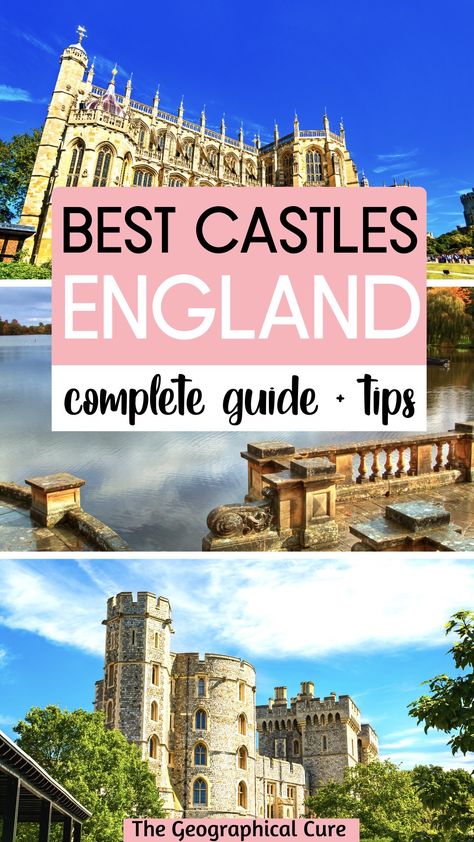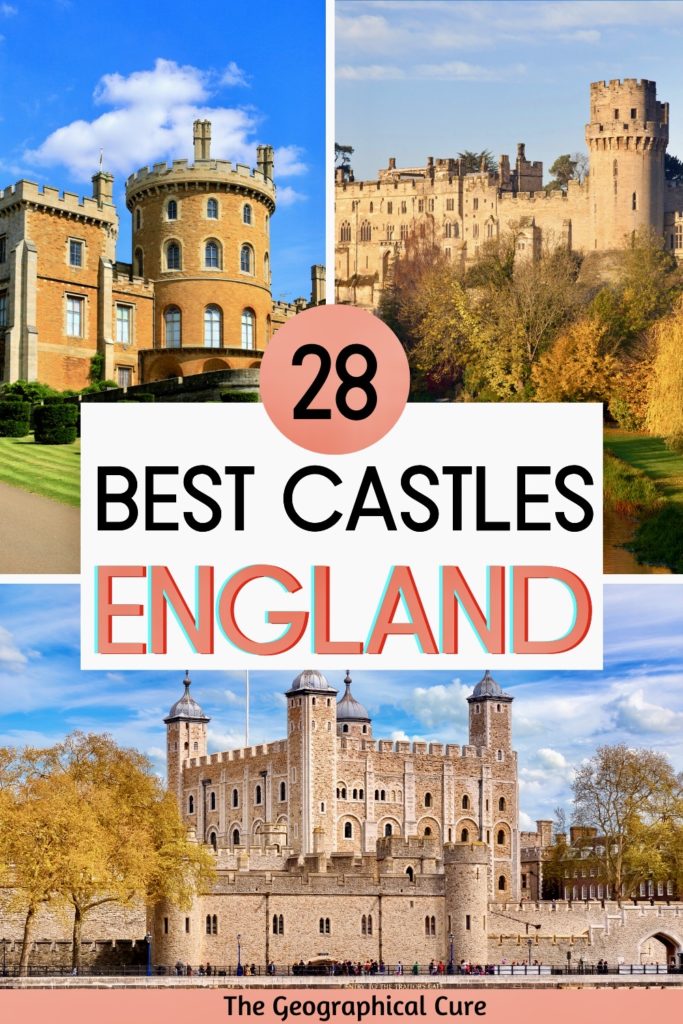Are you a castle lover heading to England? Here’s my guide to the 28 best castles in England to put on your bucket list.
I must admit I’m a little obsessed with castles, and England is the perfect place for castle stalking. The country is blessed with scores of fairytale castles, both massive and petite.
Many of these English castles are UNESCO World Heritages sites or heritage monuments. They come complete with intriguing backstories, having set the stage for family feuds and pivotal events in British history.
Some of these English castles are in ruins. Others are well preserved medieval edifices. All of them boast picturesque settings — clinging to cliffs, rocky outcrops, or set amid shimmering moats.
On a visit to these amazing castles in England, you’ll step back in time and have a royal day out. Many of these castles make great day trips from London.
History Of Best Castles In England
Castle building in England began in earnest after the Norman Conquest in 1066. William the Conqueror used them both for defense and as a symbol of Norman power.
The first castles were wooden “motte and bailey” designs. This meant a wooden keep was built on a raised mound (the motte) with an enclosed courtyard (the bailey). The “keep” was the center and most fortified part of the castle.
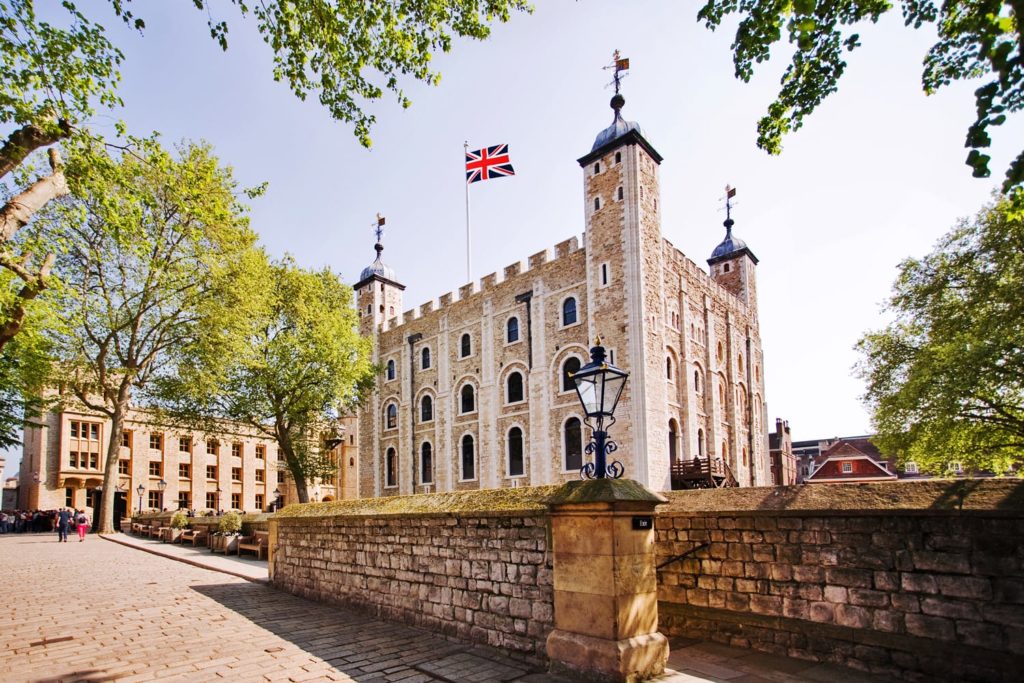
Soon enough, wooden castles gave way to stone castles with elaborate gatehouses, towers, and curtain walls. Towers were of supreme importance. They were used to fire weapons, sling arrows, or pour boiling liquids down on the invading enemy through “murder holes.”
Some castles fell into ruins. Sometimes they remained in ruins because their strategic value had diminished or because the owners couldn’t afford to rebuild them.
In the Tudor era, comfort became more important than defense and castles were given less fearsome facades. Many castles became royal property with lavish interiors more akin to palaces.
Long after these castles in England ceased to have a practical defensive function, they were often kept by their owners for sentimental or historic reasons. Some, like Windsor Castle, are still in use.
Despite their sometimes violent past, many of these English castles are the epitome of romance.
If you are not a resident in England and want to visit several castles, you may benefit from buying an English Heritage Pass for Overseas Visitors. This pass is valid at over 100 properties and is available for 9 or 16 days.
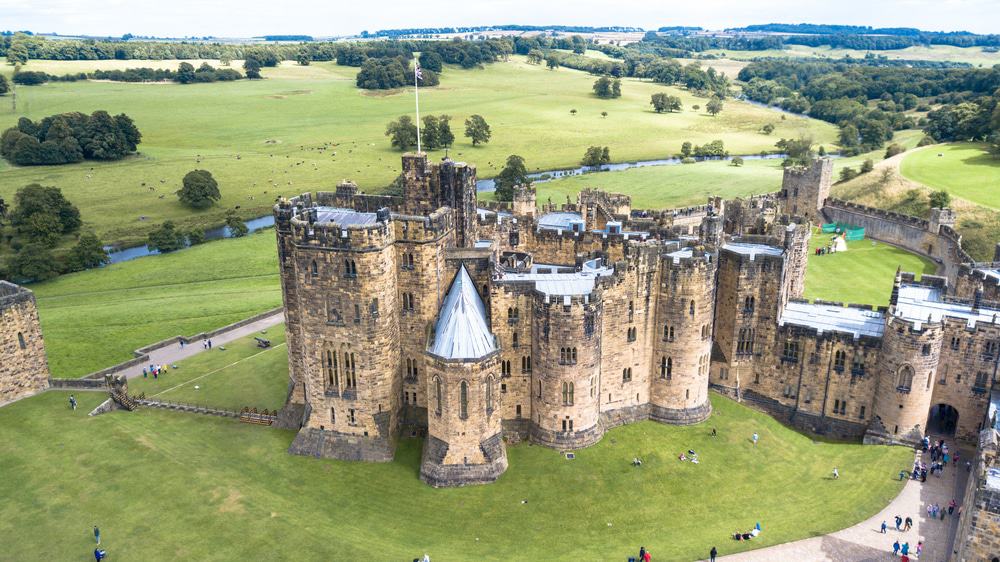
Best Castles In England To Visit
Here are my picks for the 28 best castles in England. I’ve put them in alphabetical order for ease of reference. So cue up your dreamy sighs and let’s explore some amazing English castles.
1. Alnwick Castle, Northumberland
Alnwick is one of the best known castles in England. It’s popular partly for its fame as a Harry Potter filming location.
Alnwick is the seat of the Dukes of Northumberland and is England’s second largest inhabited castle (after Windsor).
The de Veschy family began building the castle in the 12th century. It was one of the first castles without a square keep. When the family line died out, the Percy family claimed the castle.
The first Percy transformed the defensive castle into an even more formidable stronghold and palatial residence. He and his son built the massive towers on each side of the keep’s entrance.
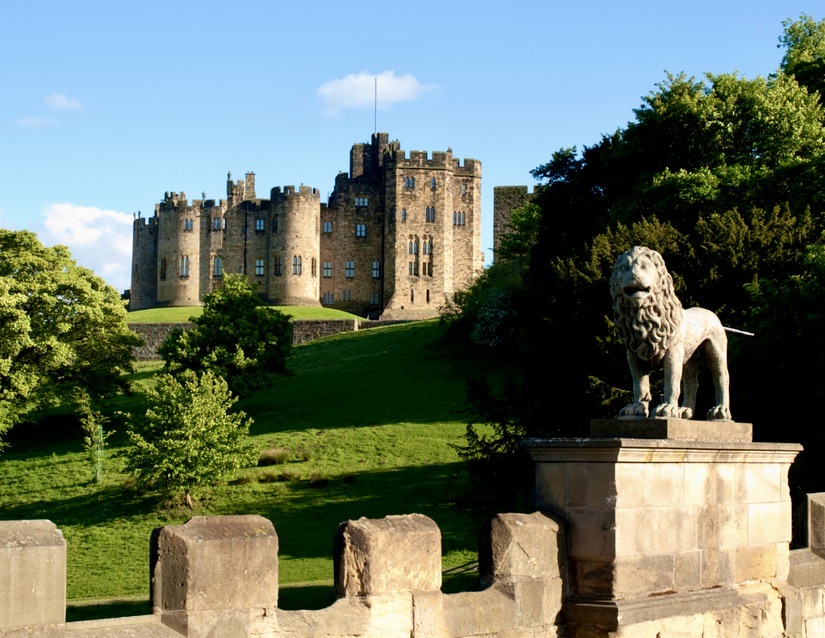
The Percys were intertwined with important events in British history. Hotspur Percy helped Henry Bolingbrook ascend to the throne as Henry IV and became guardian of his son, a young Henry V.
Alnwick Castle also has a spectacular garden renovated by the current duchess. It’s home to over 4,000 species of plants, orchards, pathways, ponds, and the Grand Cascade fountain.
Alnwick Castle starred as Hogwarts School of Witchcraft and Wizardry in the 2001 film Harry Potter and the Philosopher’s Stone and the 2002 film Harry Potter and the Chamber of Secrets. The Outer Bailey is where Harry learned to fly a broomstick.
You can visit Alnwick Castle on a guided day trip from Edinburgh.
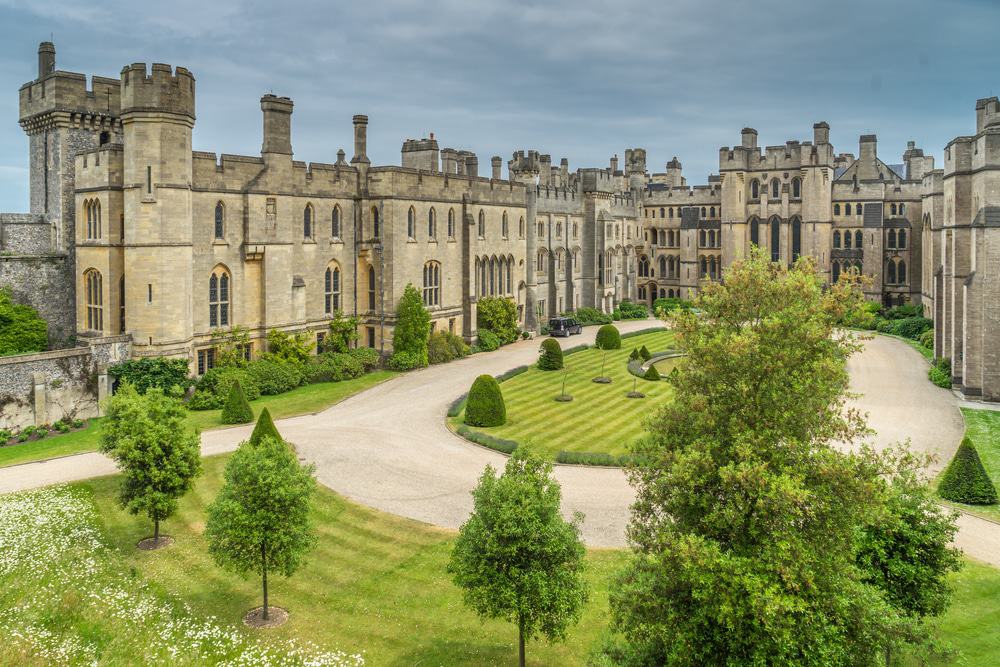
2. Arundel Castle, West Sussex
The town of Arundel is home to one of the best medieval castles in England. Arundel Castle is 1,000 years old.
For centuries, it was the seat of the Earls of Arundel. Since Richard III’s reign, it’s been the Duke of Norfolk’s principal home.
The castle fell into ruin in the mid 17th century after the English Civil War between parliamentarians and royalists. It was later rescued and restored in the 18th and 19th centuries.
The castle follows much the same plan as Windsor Castle. It has a central moat and two baileys to the north and south, curtained with thick walls.
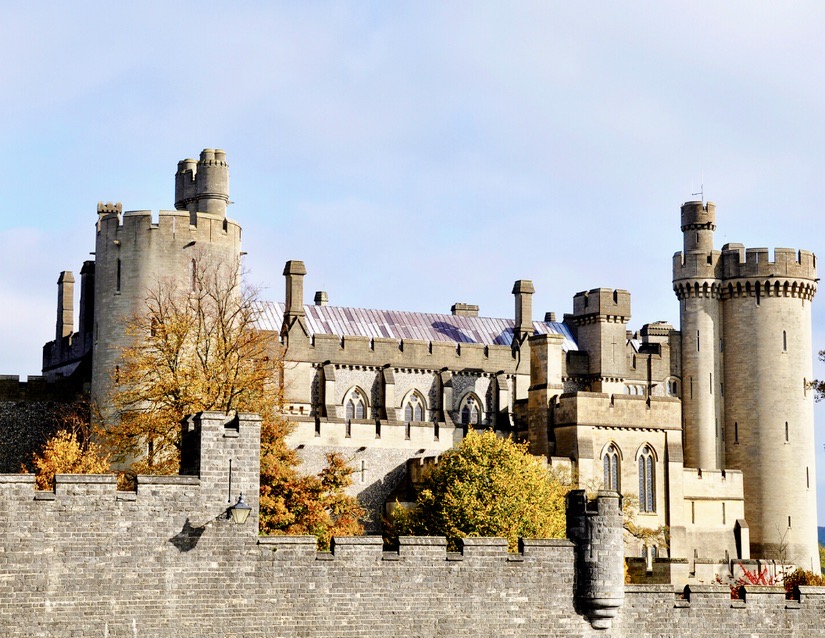
While, it looks medieval, Arundel was actually restored in a Norman style in the Victorian era. So it’s a bit ersatz.
If you climb up the steps of the keep, you’ll have a spectacular view of the River of Arun, the sea, and the town itself.
Arundel Castle also has some magnificent gardens to explore. If you plan to visit in the spring, you can admire the 60,000 tulips that bloom on the property.
In 2021, thieves broke into the castle and made off with artifacts valued at over $1.4 million, including the enameled rosary beads carried by Mary Queen of Scots at her execution in 1587.
You can combine a visit to Arundel castle with the romantic Amberley Castle, just 4 miles down the road. Fortified in the 14th century, Amberley has a dramatic 60 foot wall and twin tower gatehouse.
The castle is privately owned, but you can stay overnight in unabashed luxury by booking one of 15 rooms in the manor house, tower, or Bishop’s Hall.
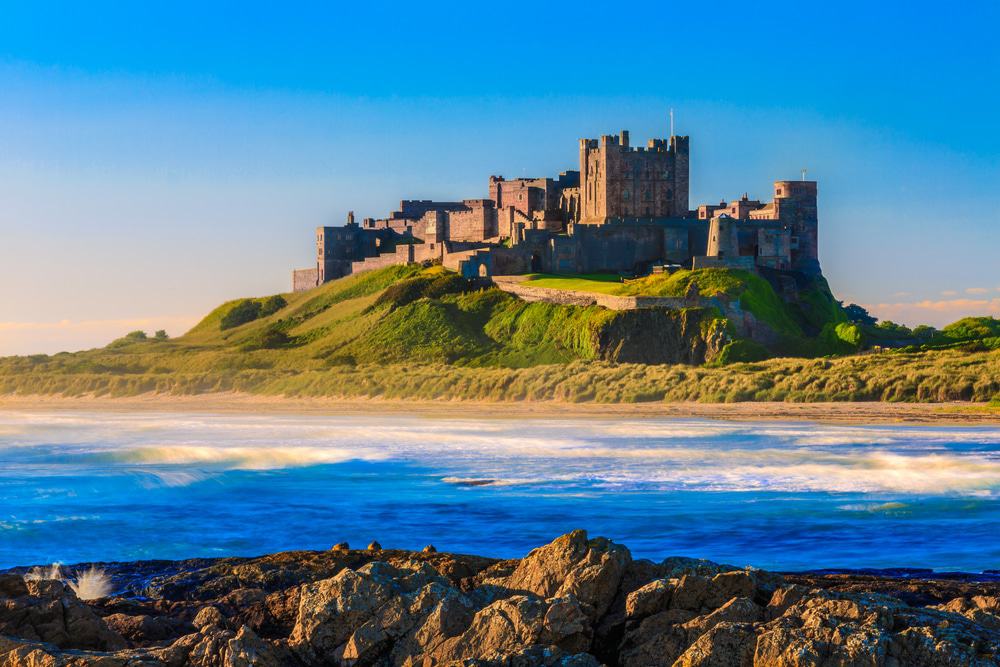
3. Bamburgh Castle, Northumberland
The history of Bamburgh Castle dates back to 420 A.D., when it was a Roman citadel. This makes it one of the oldest and best castles in England to visit.
Situated on a hill overlooking the North Sea, Bamburgh remained an impregnable fortress and royal stronghold for around 400 years. It was intended to stave off Scottish invaders and Viking raids.
The castle’s great keep was the work of Henry II. In the 15th century War of the Roses, Bamburgh became the first castle to be ever defeated by artillery, a new weapon of war.
By the 16th century, the castle was in ruins with only the keep intact. Lord Armstrong bought the castle in the Victorian era and began a massive renovation.
Nowadays, you can head inside to explore the staterooms, grounds, and the magnificent beach it looks over. There are 14 rooms open to the public with over 3,000 artifacts and exhibits. The King’s Hall is the most impressive room, with an intricate wooden ceiling.
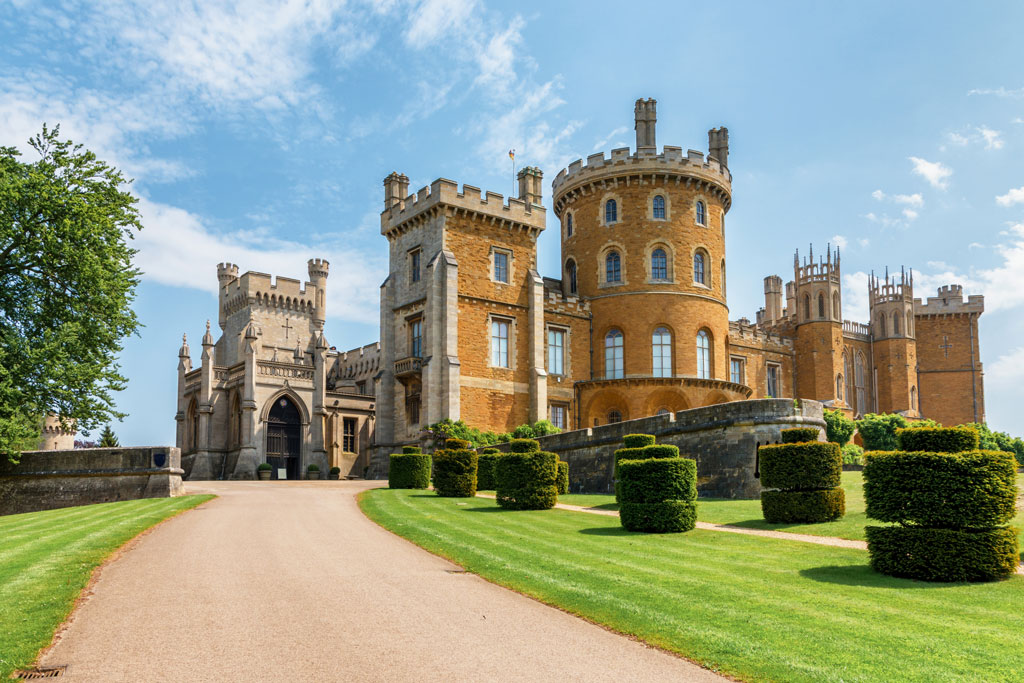
4. Belvoir Castle, Leicestershire
Belvoir Castle is a romantic mock castle in England with an interesting 1,000 year history. It’s a romantic amalgam of architectural styles that make it movie set pretty. And, in fact, Belvoir doubled as Windsor Castle in season 3 of The Crown and in Young Victoria.
The name “Belvoir” translates to “beautiful view.” But the castle’s name is actually pronounced “Beever.”
The first castle on the site was built after William the Conqueror’s ascension to the throne. Belvoir was then in the hands of the Albini and de Roos family for centuries.
The castle was damaged in the War of the Roses. The first Earl of Rutherford got rid of the medieval remnants and turned it into a Tudor manor home.
That castle was then destroyed twice and rebuilt, for the final time, in the Victorian era in a Regency style. Queen Victoria was one of the castle’s many illustrious guests.
A must see room inside is the Regent’s Gallery. It displays Gobelin tapestries that once belonging to Louis XIV of France. The tapestries tell the story of Dion Quixote.
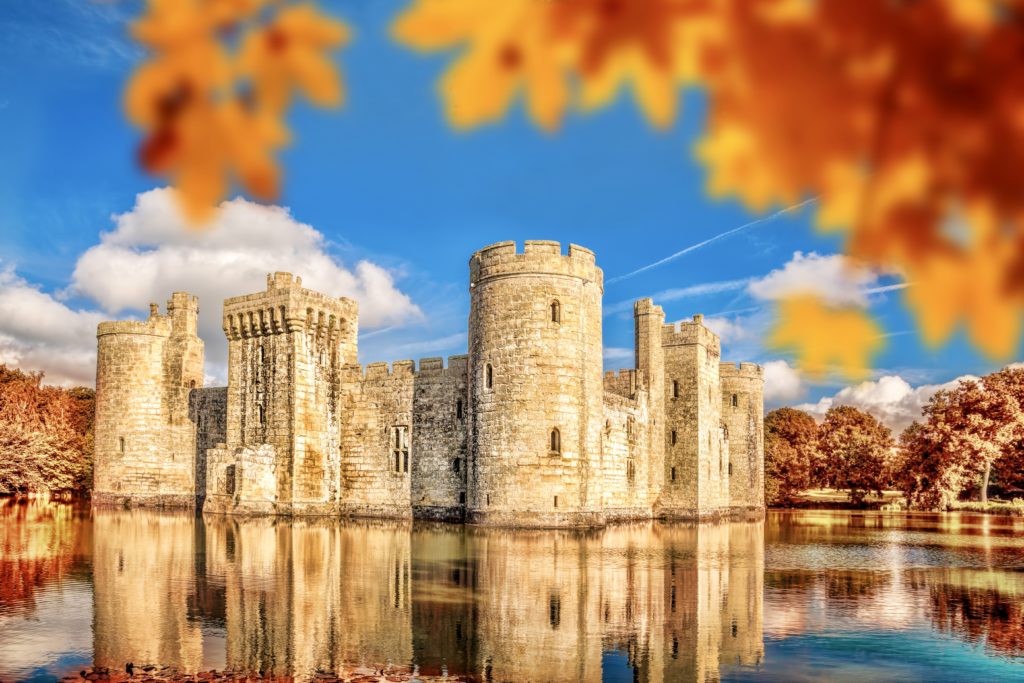
5. Bodiam Castle, East Sussex
Bodiam Castle is one of England’s true storybook castles. It’s a square fortress completely surrounded by a large lake-like moat.
Built in the 14th century by the wealthy Sir Edward Dallingridge, Bodiam is one of the last medieval castles in Britain. It has a perfect symmetry with stout drum towers at each corner and crenellated walls. Conceived as a courtyard castle, it has unusually open middle grounds.
Like many castles of this period, Bodiam combined a fearsome facade with luxury elements. There were big rooms, toilets, and fireplaces.
By the 17th century, Bodiam was a celebrated and romantic ivy clad ruin. The exterior was restored in the 19th century.
You can take the free guided tour or explore each nook and turret on your own. There’s a parking lot on site and you pay at the kiosk.
Bodiam Castle offers free tours that occur almost every day and give a brief history of the castle. The tours start at 12:15 pm and 2:15 pm and last around 35-45 minutes.
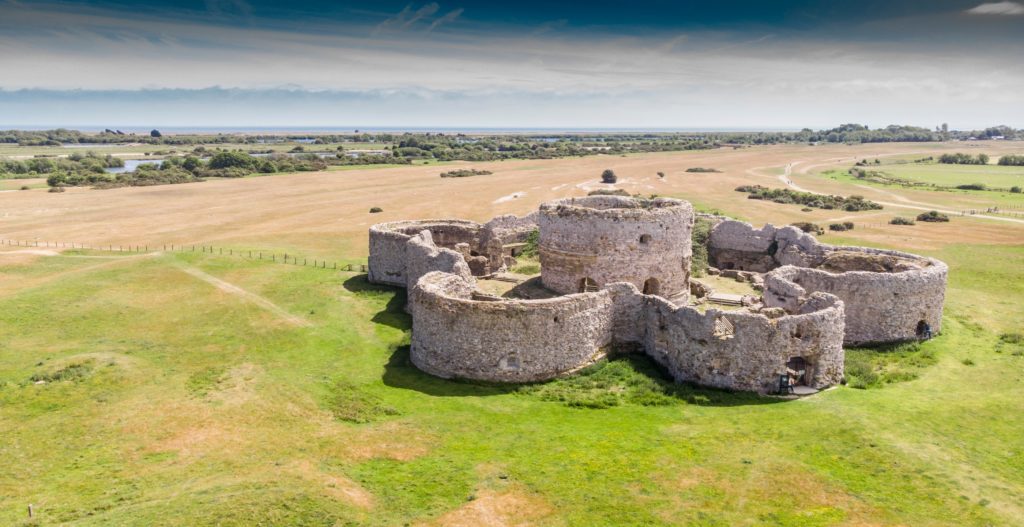
6. Camber Castle, East Sussex
Camber Castle is a one mile walk from the picturesque town of Rye in Kent. It’s also known as Winchelsea Castle.
It’s a 16th century Henry VIII “gun fort” built in the shape of a flower. It was built to defend Rye Harbor against French attacks.
The castle lies in ruins. You can’t go inside, but you can admire the atmospheric exterior.
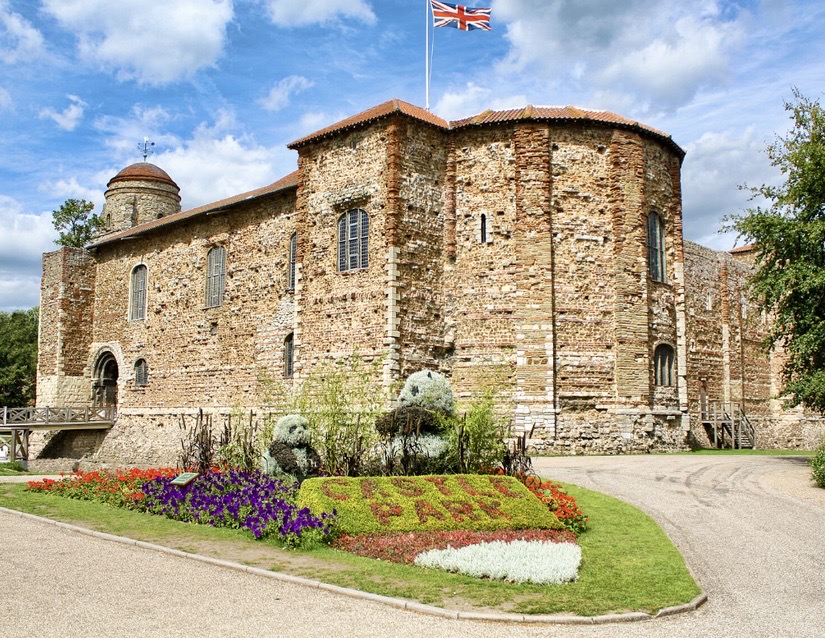
7. Colchester Castle, Essex
Colchester Castle was built in the 11th century and has the largest keep of any castle in England. It was built on the foundations of the Roman Temple of Claudius, linking the Normans with the glory of Rome.
Today, it’s more museum than castle. But the Castle Museum is well worth the visit.
It houses important archaeological artifacts covering 2,500 years of history, including the most important Roman finds in Britain. The most famous piece is the Sheepen Cauldron, a huge and mysterious vessel dating from the Bronze Age in the 2nd century B.C.
An interactive tablet also shows you how the castle would have looked in its heyday.
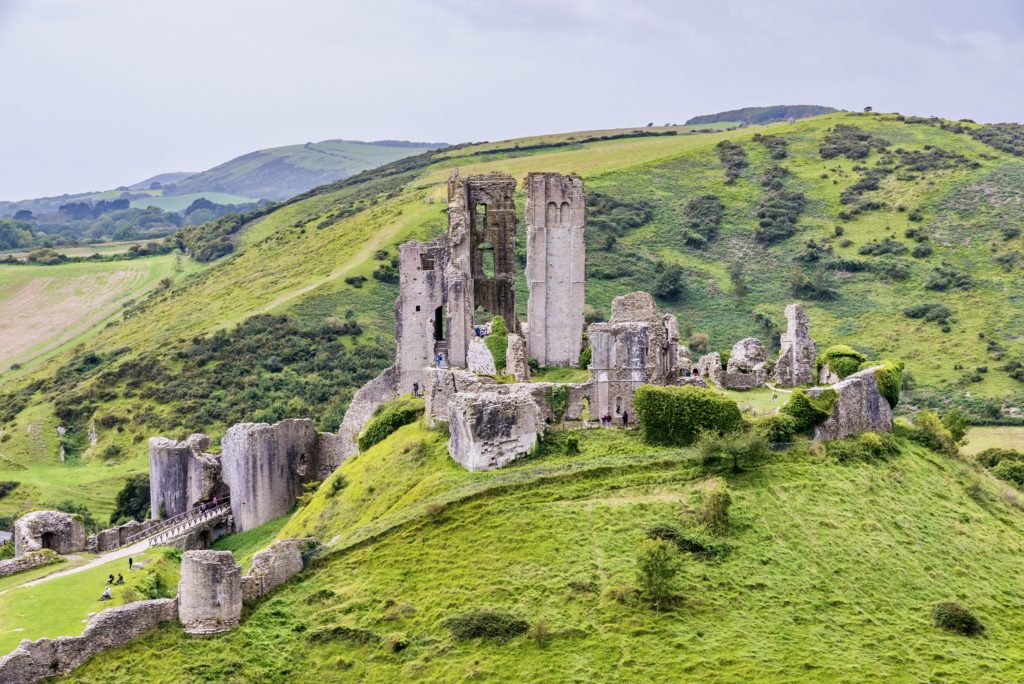
8. Corfe Castle, Dorset
The once powerful Corfe Castle now lies in jagged ruins. This English castle was built by William the Conqueror in the 11th century and destroyed in the English Civil War.
Corfe was an important castle in England. Its location gave William access to southern coast and his homeland. Unlike other Norman castles, it was built out of stone, not wood, further underscoring its importance.
After William, Corfe Castle was a favorite of John and Henry III, who built curtain wall, towers, and a gloriette (a castle within a castle). It remained in royal hands until Elizabeth I sold it to one of her favorite courtiers. In 1635, Sir John Bankes bought the caste.
In 1642, the English Civil War broke out, pitting parliamentarians against royalists. Lady Bankes held out against the parliamentarians until she was betrayed by one of her own officers. As punishment, Corfe Castle was destroyed.
When the monarchy was restored in 1660, Corfe Castle was returned to the Bankes family. But they chose not to rebuild it. In 1982, they bequeathed the castle to the National Trust.
Today, you can wander through the picturesque archways and explore the west bailey, the oldest surviving section of the castle.
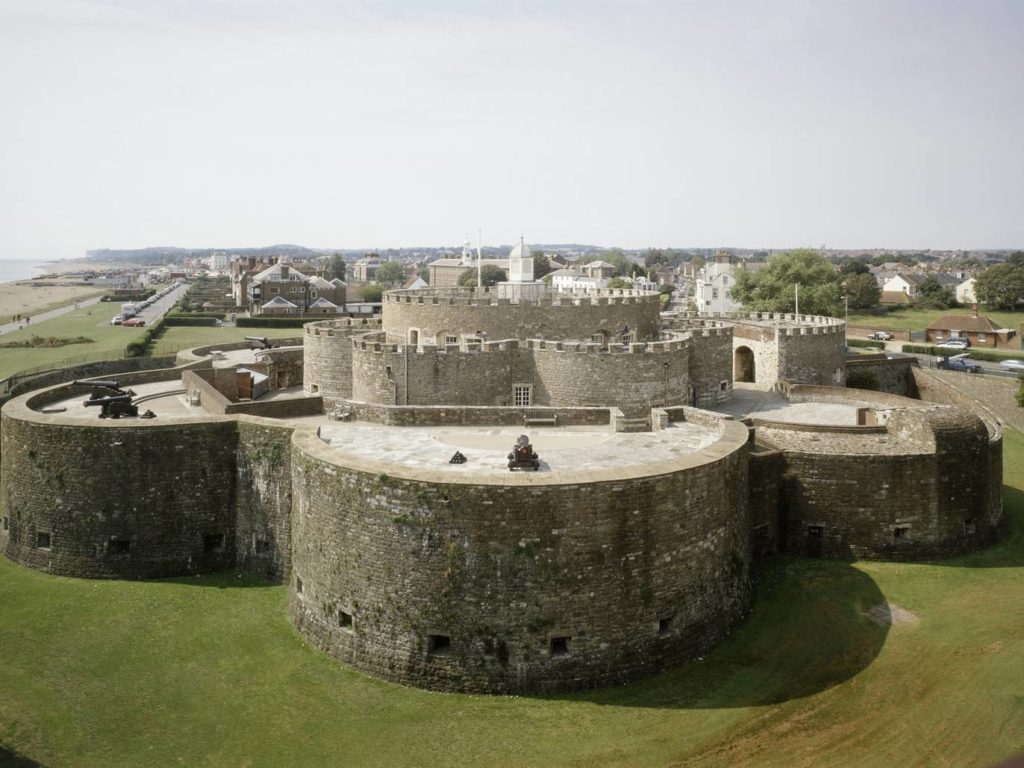
9. Deal Castle, Kent
Built in 1539-40, Deal Castle was the largest of Henry VIII’s “gun forts.” It was built to protect England’s southern coast against the threat of invasion from France and the Holy Roman Empire. The castle was funded by Henry’s dissolution of the monasteries after the Reformation.
Deal Castle has a large central keep with six huge round bastions and an outer moat. It was meant to appear menacing, and it looks almost extraterrestrial.
In total, the castle features 66 firing positions. When viewed from the air, the castle takes on the sexfoil pattern of the Tudor rose.
Deal was famous as the spot where Henry’s fourth wife, Anne of Cleves, landed when she came to England in 1539.
The castle’s information center gives you a good history of the castle and Henry’s military strategies. There are beautiful coastal views from the top of the bastions.
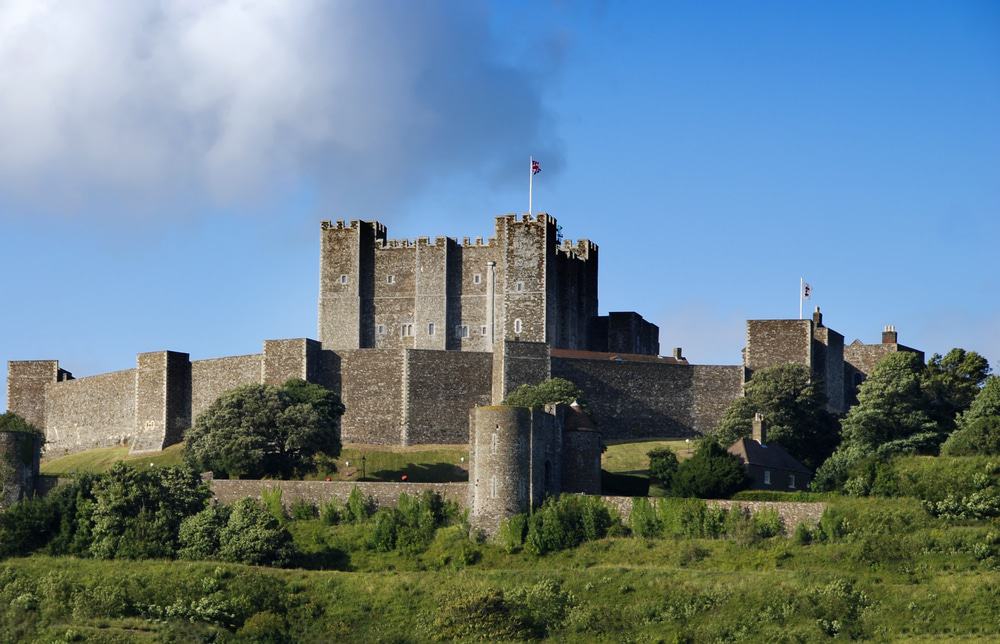
10. Dover Castle, Kent
Dover Castle is awesome in scope and size. Medievalists will be delighted by one of the oldest and best castles in England.
The first fortification on the site dates from the Iron Age. The strength of Dover’s position on the sea was so impressive that even Julius Caesar said it was “no place to attempt a landing” when he attacked England. The Romans further fortified it and then the Saxons moved in.
One of the greatest Norman monarchs, Henry II, built the imposing 12th century keep you see today. He was determined to keep England safe from France, which was just 17 miles away. Dover was a formidable castle the likes of which had never been seen before.
The central keep was 80 feet tall and the walls 100 feet long. The inner wall had 14 towers to accommodate archers.
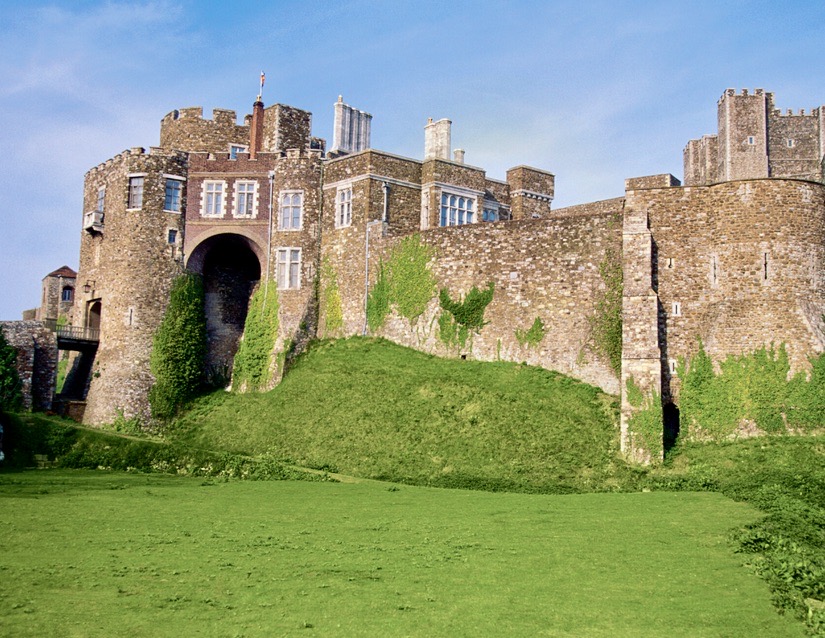
The castle was never breached, though Prince Louis of France almost succeeded in 1216. You’ll find a multi-media exhibition dramatizing the event.
After that close call, Henry III improved Dover’s fortifications once again. He also added the great hall and royal accommodations.
Much of what you see today is unchanged from that era. The castle could take all day to explore, if you wanted to poke into every nook and cranny.
The castle’s highlight is the central keep with its Great Hall, royal chambers, and private chapel.
The Constable’s Gateway is also impressive, with a labyrinth of tunnels that were important to medieval defense and served as an operations center during WWII. You’ll see examples of Medieval and Tudor arms and weaponry.
You can visit Dover castle along with the town of Canterbury on a guided day tour from London. You can also check out my complete guide to spending one day in Dover on a day trip from London.
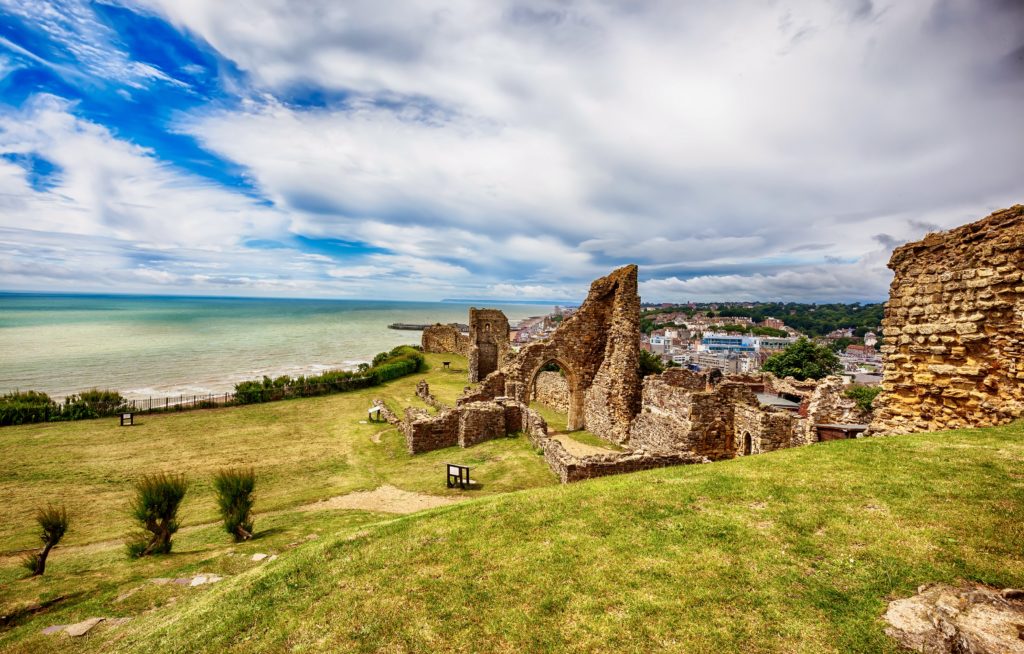
11. Hastings Castle, East Sussex
Hastings Castle is an 11th century ruined castle built by William the Conqueror after landing in England. With a good harbor and site at the end of a peninsula, it was easy to defend.
The building of the castle is depicted in the famed Bayeux tapestry, which chronicles the events leading up to William’s invasion of France.
From this stronghold, William rampaged through southeast England, leading a campaign of intentional destruction and looting.
All the remains of the historic castle is a few walls and crumbling stone structures.
Because it’s perched high on a steep cliff, Hastings is not the easiest castle to visit. The only way up is via a steep staircase or funicular.
While visiting Hastings, you can watch 1066 Story, a 20 minute film on the fascinating history of the castle and the battles that decided England’s fate.
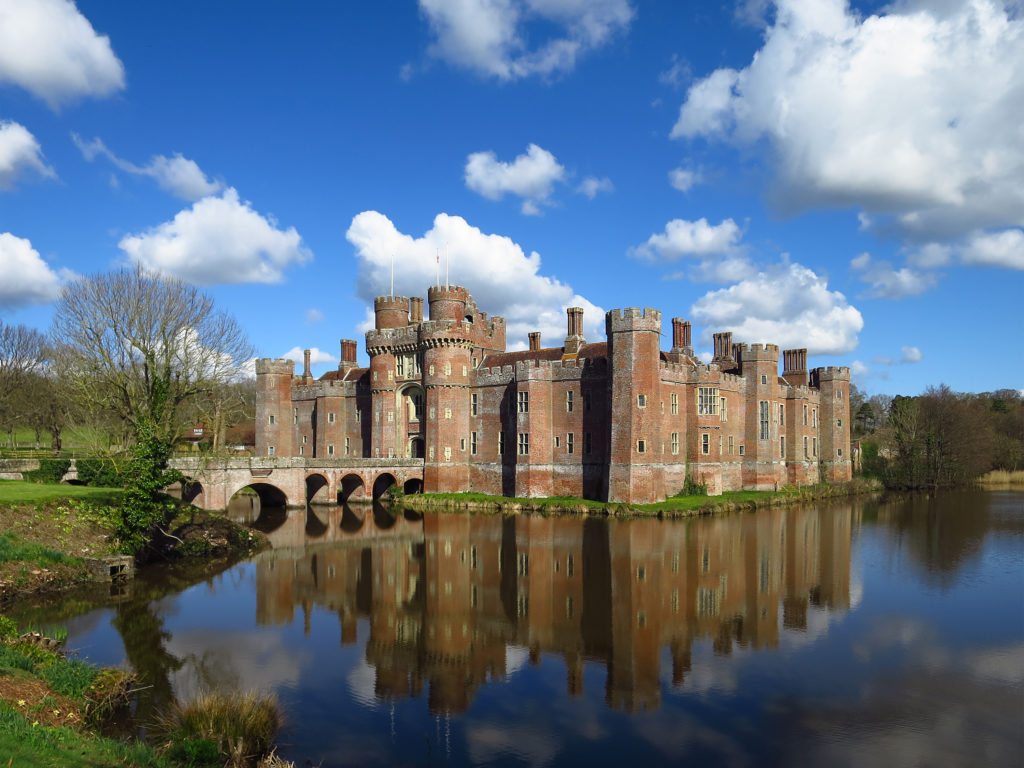
12. Herstmonceaux, East Sussex
Like Bodiam Castle, Herstmonceaux Castle was built to stave off possible French invasion. The 15th century castle is really more manor house than craggy castle.
Still, the castle has a battlements, a moat, and 300 acres of lovely gardens and woodland. The Elizabeth Garden is the most exquisite, with its rambling roses and daisies.
The red brick exterior is original, but the interior has been completely remodeled.
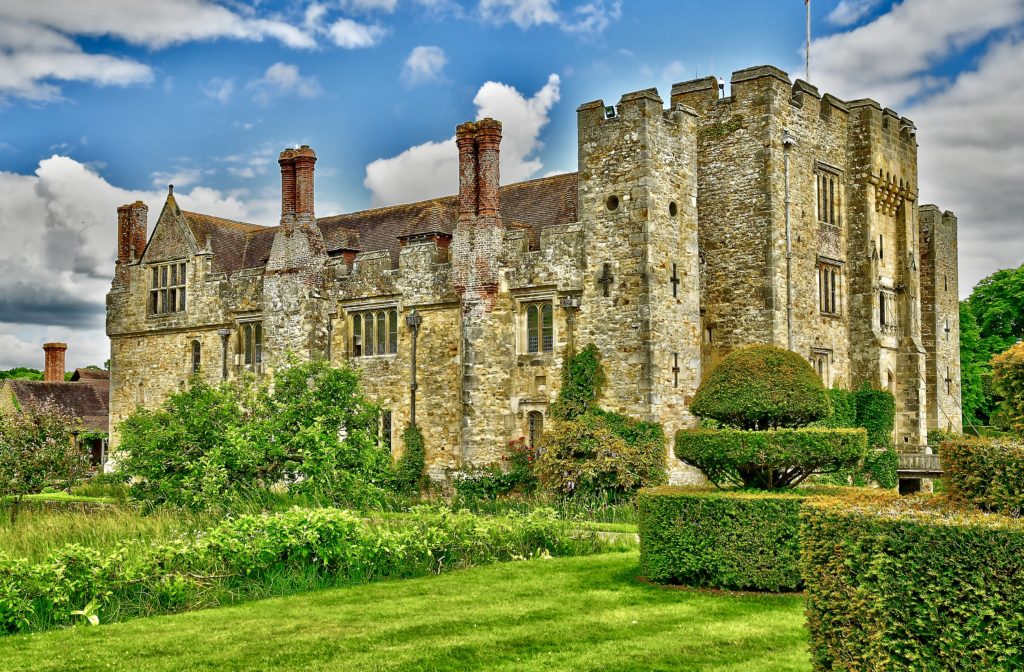
13. Hever Castle, Kent
If you’re a Tudor enthusiast, Hever Castle is one of the best castles to visit in England. Hever is a petite double-moated castle with a craggy romantic visage that’s largely unaltered by time.
It’s famously linked to the ill-fated royal couple, Anne Boleyn and Henry VIII. Their story is a fascinating one, one of the most dramatic in English history.
Hever was the childhood home of Anne, Henry’s second wife. It’s also linked to Henry’s fourth wife, Anne of Cleves, who was installed there after Henry divorced her in favor of Anne.
On a visit to Hever Castle, you can walk in the footsteps of these famous Tudor monarchs. And you can admire the castle’s medieval keep and gatehouse, Tudor rooms, original portraits, and exquisite gardens.
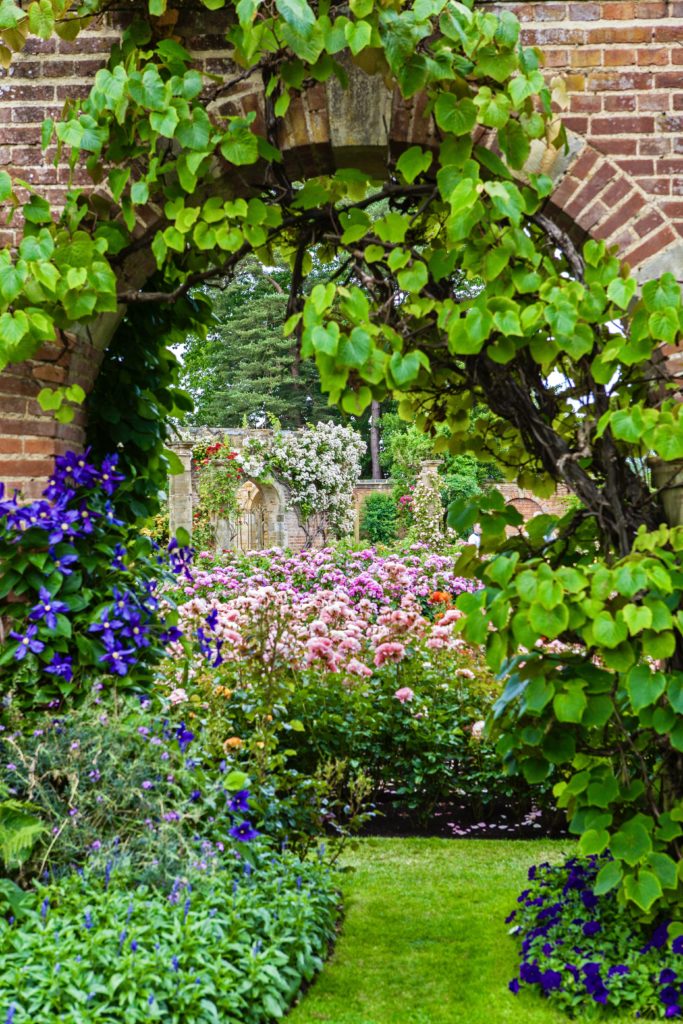
The award-winning gardens are set over 125 acres. The peerless Italian Garden is the highlight of the castle gardens. It’s the setting for a collection of classical statuary from Roman to Renaissance times.
You can also row boats on the 38 acre lake, wander through yew and water mazes, sniff roses, or try your hand at archery. There’s even an open water swimming course.
Here’s my complete guide to Hever Castle. You can get to Hever Castle from London on several guided day tours:
- a full day guided Tudor tour of Hever Castle and Hampton Court Palace
- a private half day tour to Hever Castle
- or a 6-8 tour of Hever Castle and Garden
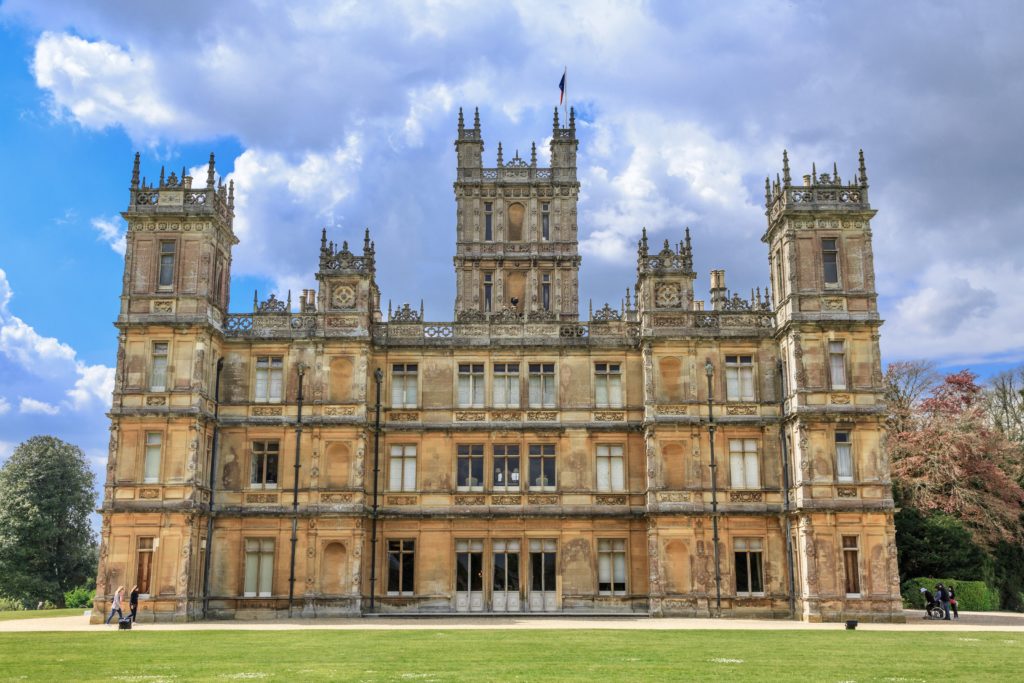
14. Highclere Castle, Hampshire
Highclere Castle is the country seat of the Earl of Carnarvon and one of England’s best and most beautiful castles. The stunning 300 room castle is most famous, though, as the real life Downton Abbey from the hit British period TV series.
Originally built in 1679, the castle was remodeled in the 1840s by the same architect who designed the Houses of Parliament in London. Famous landscape architect Capability Brown designed the gardens.
Royalty, politicians, famous writers, and film stars have stayed at Highclere Castle.
The current Earl’s family has been living on the estate since 1679. The Carnarvon are a busy lot. They’ve been involved in the founding of Canada, the discovery of King Tutankhamun’s tomb in Egypt, scandalous affairs, and sordid court cases.
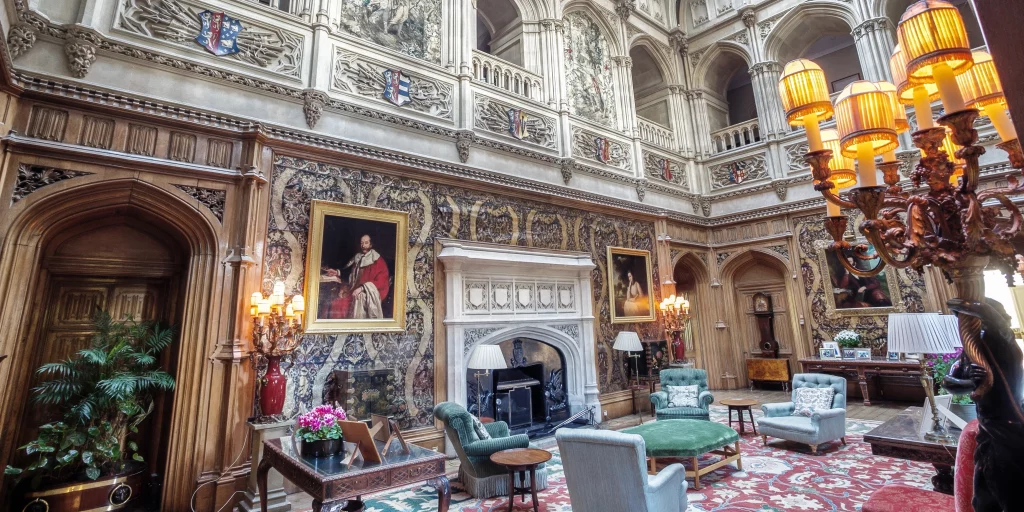
The main things to see are the State Rooms, the Egyptian Exhibition, and the gardens.
The castle is open seasonally, so check opening dates on the website before planning a visit.
Highclere has some special events throughout the year, including an Easter Egg Hunt, Afternoon Tea, and various Christmas events. These events sell out quickly, so you should pre-book tickets online in advance.
The easiest way to get to Highclere is by car.
If you’d rather take a guided tour, this one includes a visit to Highclere Castle and other Downton Abbey filming locations. You can also book a guided tour from London that combines Highclere and Stonehenge.
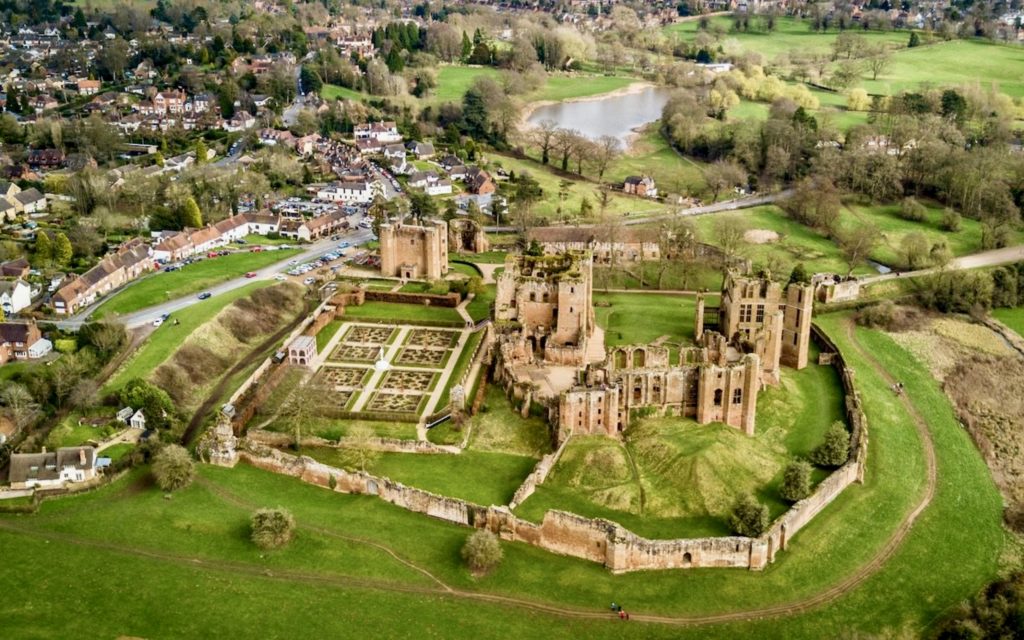
15. Kenilworth Castle, Warwickshire
Kenilworth Castle was once the seats of medieval nobles. Today, the former castle lies in a heap of evocative ruins.
But what lovely ruins they are for ruin lusters. This is a place where your imagination can run wild.
Kenilworth has a compelling history and a colorful cast of characters. Sir Geoffrey de Clinton began work on the castle in 1122. But he didn’t hold it for long.
Henry II confiscated it to defend himself against his rebellious son. The king’s other son, King John, added a curtain wall and three defensive towers. He was later forced to surrender the castle as proof of his intent to comply with the Magna Carta.
When Henry III ascended the throne, he grabbed Kenilworth back and gave it to his sister and her husband Simon de Montfort. Bad move.
Montfort was angered by Henry’s chipping away at noble rights and soon led a rebellion. He lost in one of the most famous sieges of the Middle Ages.
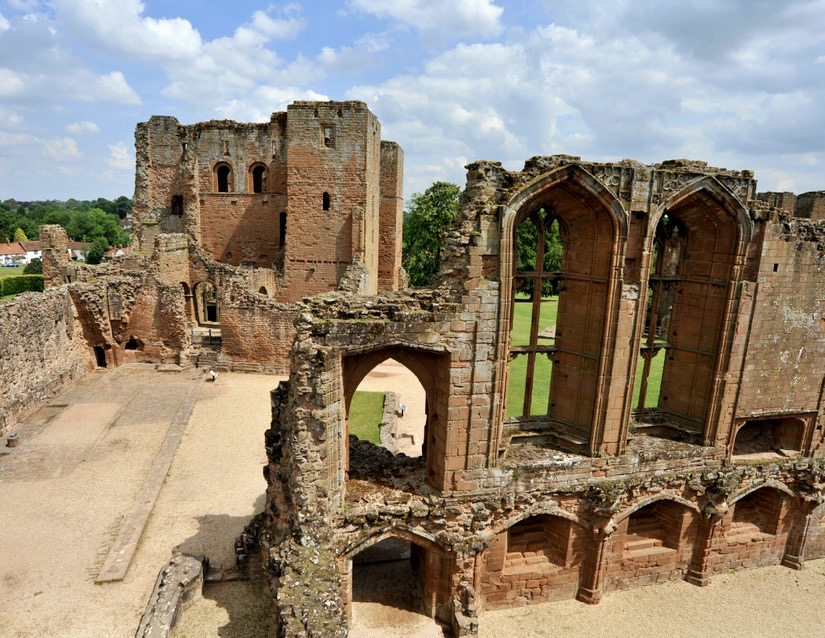
After this battle, violence gave way to a more genteel castle. The Lancastrians took ownership, gussied up the place, and built a Great Hall. Under Henry IV, the castle officially became a royal residence.
Kenilworth’s swan song came when Elizabeth I gave the castle to her favorite courtier, Robert Dudley. He built enormous guest quarters to accommodate and delight the queen and her entourage on her famous visit in 1575. After that, the castle went into decline through disinterest and abuse.
Today, you can stroll the castle grounds and reconstruct its history. Take a walk along the curtain wall and see Mortimer’s Tower and Water Tower (the best preserved bit from the 13th century).
Near the Water Tower is Leicester’s Stables, which houses an exhibit on the castle’s history. Admire the gatehouse and then venture into the inner court.
Inside, you can admire the ruins of a Norman keep with turrets. You can see balls imbedded in the walls that date from the great siege of 1266. You can also visit the former Great Hall, ascend the Strong Tower for views, and see the ruins of Dudley’s buildings for Elizabeth.
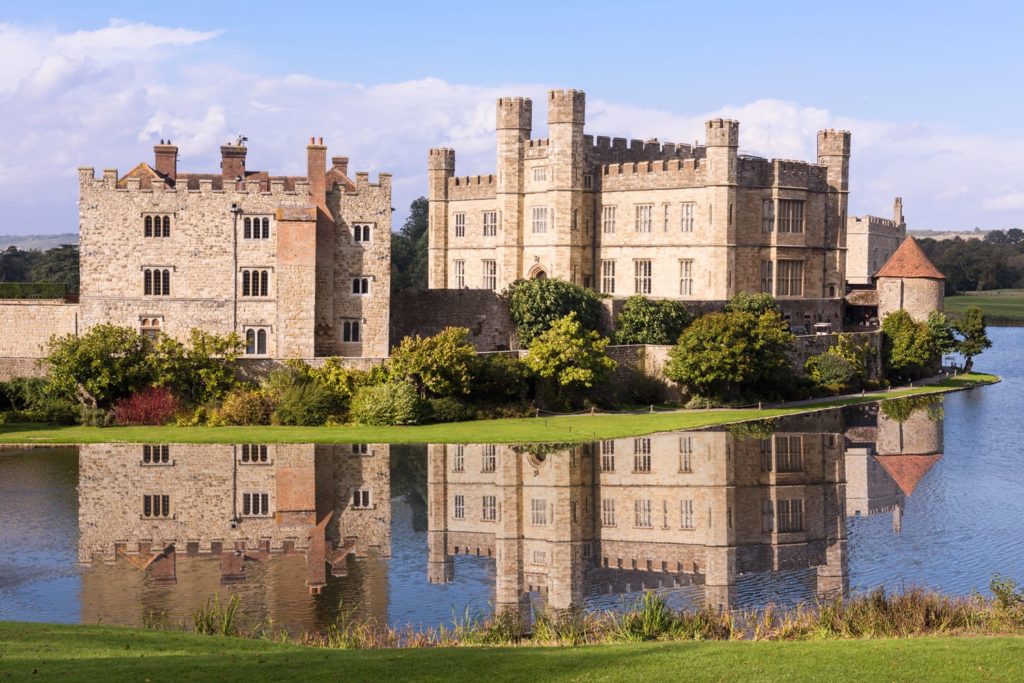
16. Leeds Castle, Kent
Leeds Castle is one of Britain’s best and most beautiful castles. The castle has a picturesque island setting on a lake in the wooded countryside of Kent.
Leeds’ history is no less romantic. Leeds Castle has been a Norman Stronghold, a Royal Palace, and the stately home of an American heiress.
Today, you can visit the New Castle, the 13th century Gloriette tower, Maiden’s Tower, and the extensive grounds and gardens.
The castle was a royal residence until Tudor times and known as the “Ladies Castle.” Seven queens lived at Leeds.
The castle was also a favorite abode of Henry VIII, who shuttled his ex-wife Catherine to live there permanently after their divorce.
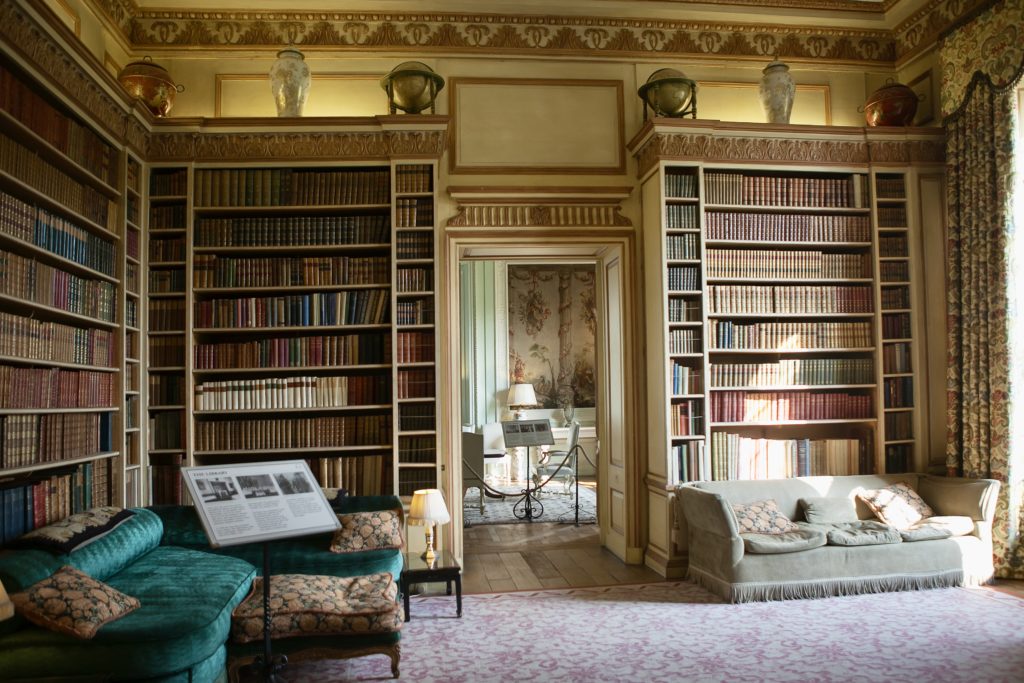
With Henry’s deep pockets, he lavished improvements on it, transforming Leeds from castle to royal palace. He added grand reception rooms, suites of rooms in the Gloriette, the graceful Maiden’s Tower, expensive glass, and fireplaces.
Thereafter, the castle fell into ruins. In 1926, American heiress Olive Paget (later Lady Baillie) purchased the castle. She saved it from centuries of neglect and restored it to medieval perfection.
You’ll be dazzled by its pristine landscaping, tasteful period furniture, and collection of medieval memorabilia.
The highlight is the Gloriette. You can visit the Banqueting Hall, the royal bedrooms, and climb the 16th century spiral staircase.
The castle is set on 500 acres of park land, landscaped by Capability Brown. The gardens include the Culpepper Garden, the Princess Alexandra Gardens, and the Lady Baillie Mediterranean Garden.
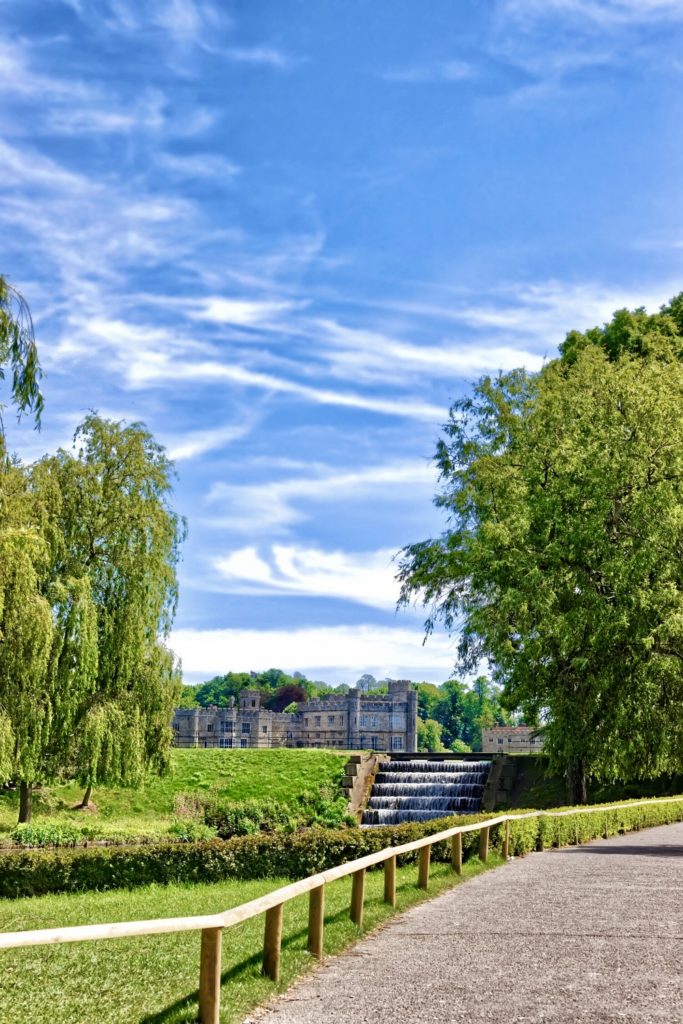
Children will enjoy the mazes, the duckery, the aviary, and the archery station.
For more information, here’s my complete guide to visiting Leeds castle. In high season, you should pre-book a skip the line ticket for the castle. It’s a bit pricey, but good for an entire year.
There are also guided sightseeing tours from London that stop at Leeds Castle. Here are some options:
- 10 hour tour combining Leeds, Canterbury, and Dover
- 11 hour tour combining Leeds, Canterbury, and Greenwich
- 8 hour private tour to Leeds and Canterbury
Leeds Castle is also one of the few castles where you can stay overnight in the lap of luxury and feel like a royal. There are traditional cottages and bed and breakfasts available to book, including:
- Weir Cottage ( 1 bedroom)
- The Oast (3 bedroom)
- Stable Courtyard (bed & breakfast)
- Maiden’s Tower (bed & breakfast)
- Holiday Cottages
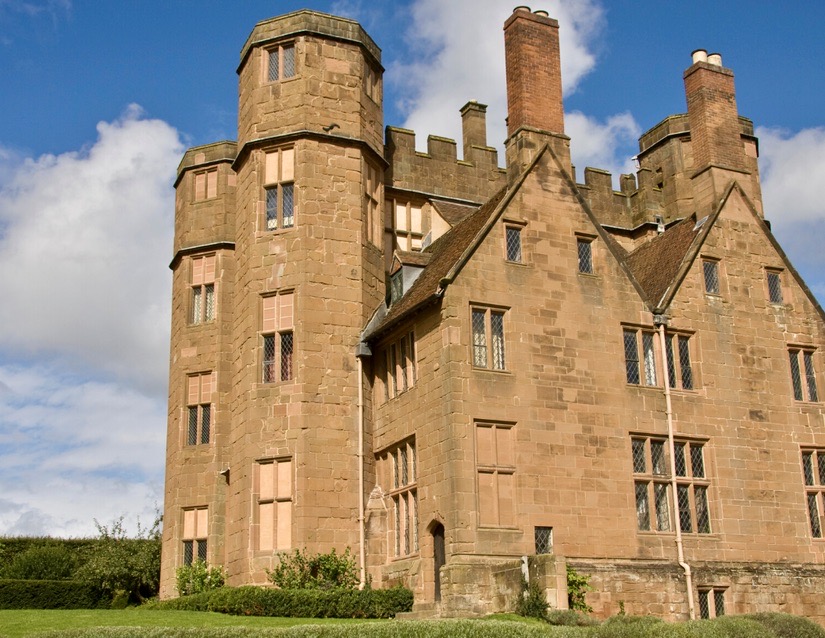
17. Leicester Castle, Leicestershire
Leicester Castle played a pivotal role in the English history. The first iteration of the castle was built just after the Norman conquest in 1066.
By the reign of Henry I, the castle had passed into the hands of the Earl of Leicester. In 1150, he set about improving the defensive structure and built a great medieval hall.
Unfortunately, Henry II sacked the castle in 1173 to squelch a rebellion. Only the Great Hall survived.
Simon de Montfort rebuilt the castle and, in the great hall, held the first English parliamentary session. But royalist forces caught up to de Montfort. He was killed and the castle passed to the Earl of Lancaster, who transformed the stronghold into a primary Lancastrian residence.
During the late 15th century, the castle was still occasionally used as a royal residence — Henry IV, Henry V, Henry VI, and Edward IV all stayed there.
Despite taking a beating during subsequent battles, two important medieval structures remain onsite: the Great Hall and the ancient Church of St. Mary de Castro.
The 12th century Great Hall is believed to be the oldest surviving castle hall with a bay, aisles, and timber roof in all of Europe. The church was the castle’s lavish chapel.
Unfortunately, the interior of Leicester Castle is mostly inaccessible, open only on special event days or Heritage Sundays. You can also attend mass at the church.
READ: One Day In Leicester Itinerary
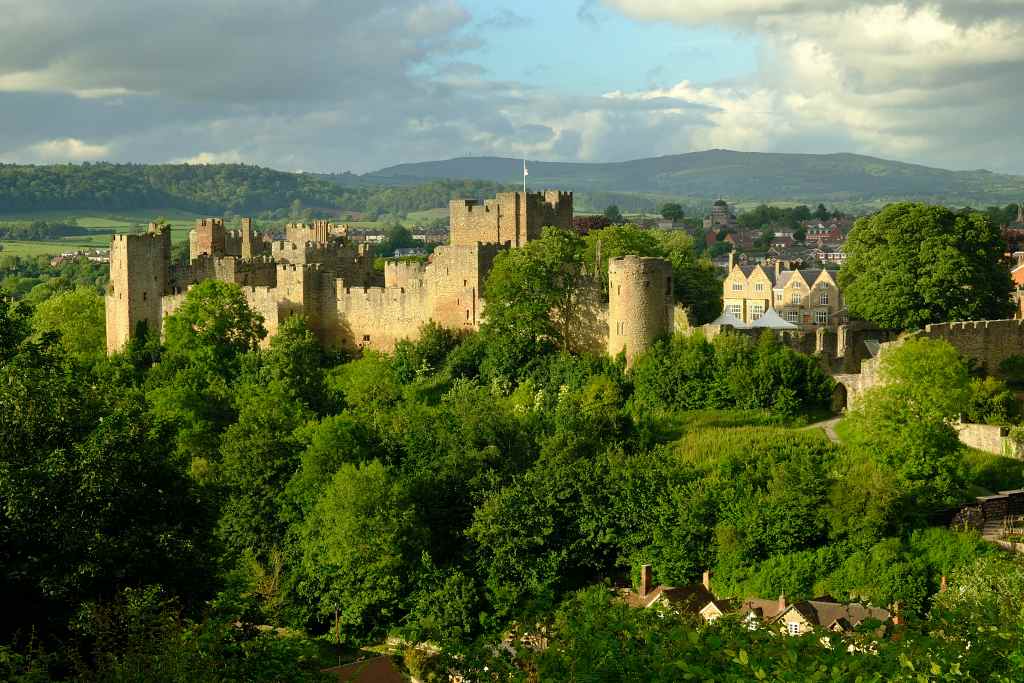
18. Ludlow Castle, Shropshire
Ludlow Castle has been dubbed the “the very perfection of decay,” so ruin lusters will think it’s one of the best castles in England.
The de Lacy family began building Ludlow in the 11th century. You can see remnants of their efforts in the gatehouse, keep, and Norman chapel. The chapel’s unique round nave, associated with the Knights Templar, still stands.
The castle came into the hands of the de Genevieve family in the 13th century and the infamous Roger Mortimer in the 14th century.
Mortimer was the secret lover of Queen Isabella and implicated in the murder of Edward II. When he grew too powerful, he was executed. The tower named for him, Mortimer’s Tower, has a semi-circular design and still stands in the bailey.
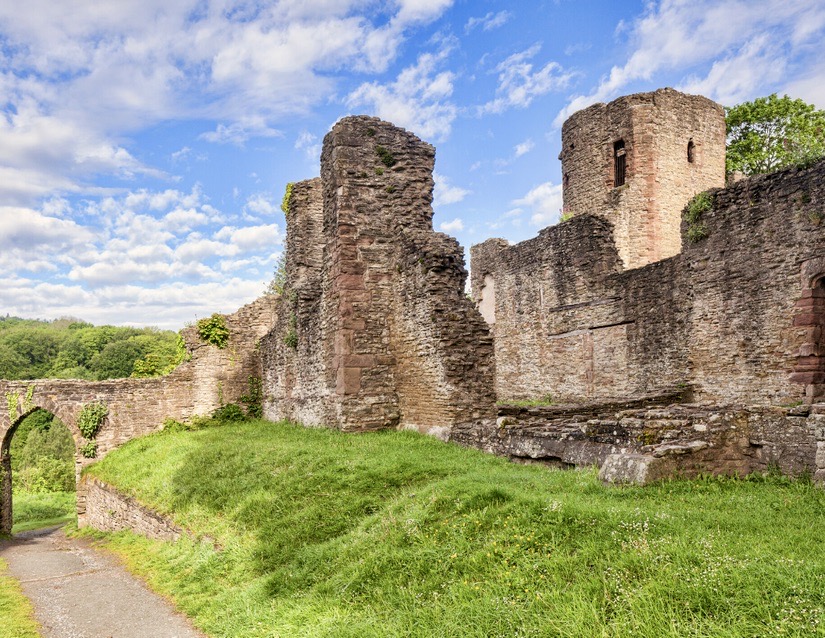
In 1461, Ludlow became a royal castle and would stay that way for the next three centuries. Edward IV’s son, Edward, was sent to live there. When his father died, he traveled to London.
But Richard III imprisoned the presumptive new king and his brother Richard in the Tower of London and they disappeared, while Richard was crowned king.
Did Richard murder the princes? It’s one of England’s most famous legends and mysteries. Even today, the fate of the princes is uncertain.
The last royal Ludlow occupant was Arthur, the son of Henry VIII, who died there. After that, the castle was abandoned and fell into the well-preserved medieval ruins you see today.
The Earl of Powis purchased Ludlow in the early 19th century. The family invested heavily to halt its decline and allow it to open as a tourist attraction. Make sure to climb up the tower for the best views over the picturesque Shropshire town of Ludlow.
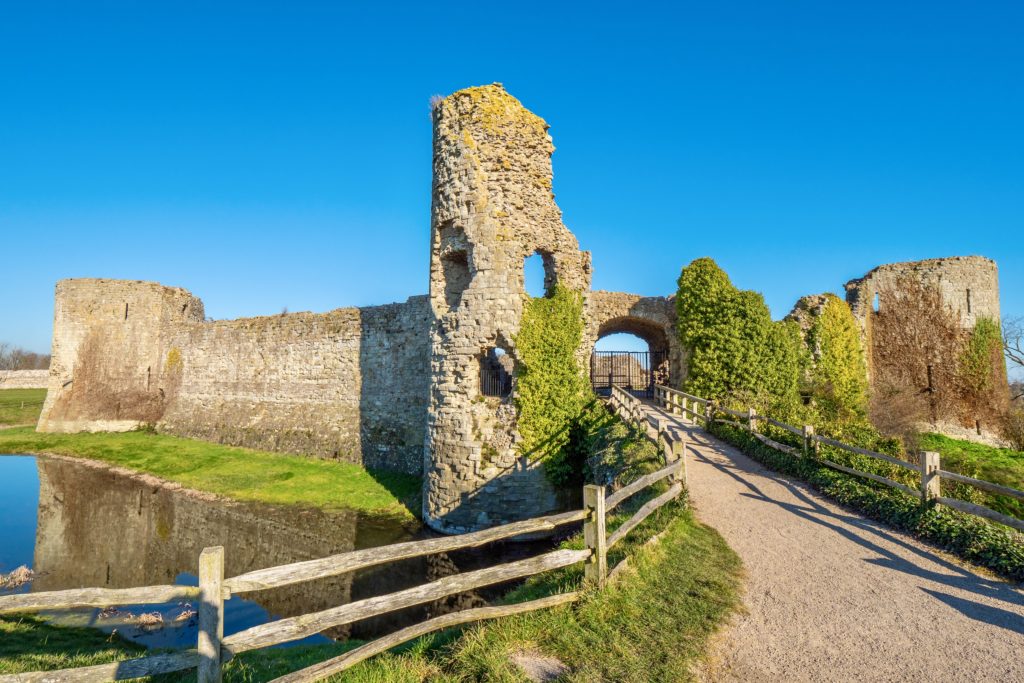
19. Pevensey Castle, East Sussex
Pevensey Castle is one of the oldest castles in England. Some scholars call it the first Norman castle in history.
Pevensey is where it all began. It was here that William the Conqueror landed to claim the throne of England in 1066.
The crumbling ruins of the castle stand high on a hill with sweeping views of the English Cannel. In its heyday, Pevensey was an impregnable fortress that never fell to assault during its turbulent history.
After the Conqueror landed, he converted an ancient defensive fort into a motte and bailey castle. Later, the Earl of Richmond built a tall curtain wall and towers.
In the 15th century, the castle was abandoned. What you see today are the remains of the impressive curtain walls, the ruins of a medieval building in the inner bailey, and a 13th century gatehouse with dungeons.
Legend holds that the ghost of Lady Pelham walks the outer walls of the castle at night. She was the wife of the castle constable.
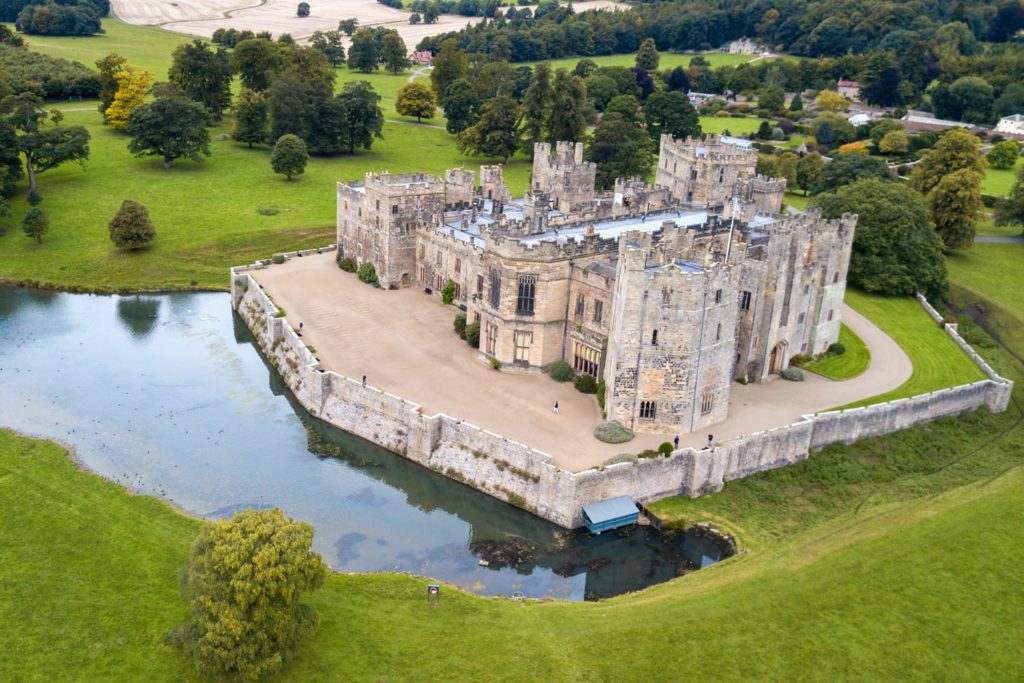
20. Raby Castle, Durham
Raby Castle is one of the finest intact medieval castles in England.
Built in the 14th century by the powerful Neville family, it has a storied history. Raby was home to Cecily Neville, the mother of two kings of England.
It was the the scene of plotting and a parliamentary stronghold during the English Civil War. When that rebellion failed, the castle was forfeited to the crown.
Originally moated and accessed via a drawbridge, Raby was built as a palace fortress. It boasts a sequence of massive towers linked by curtain walls.
Inside, the castle has Medieval, Regency and Victorian interiors. The entrance hall has tall Gothic vaulted ceilings, a massive fireplace, and armory decorating the walls.
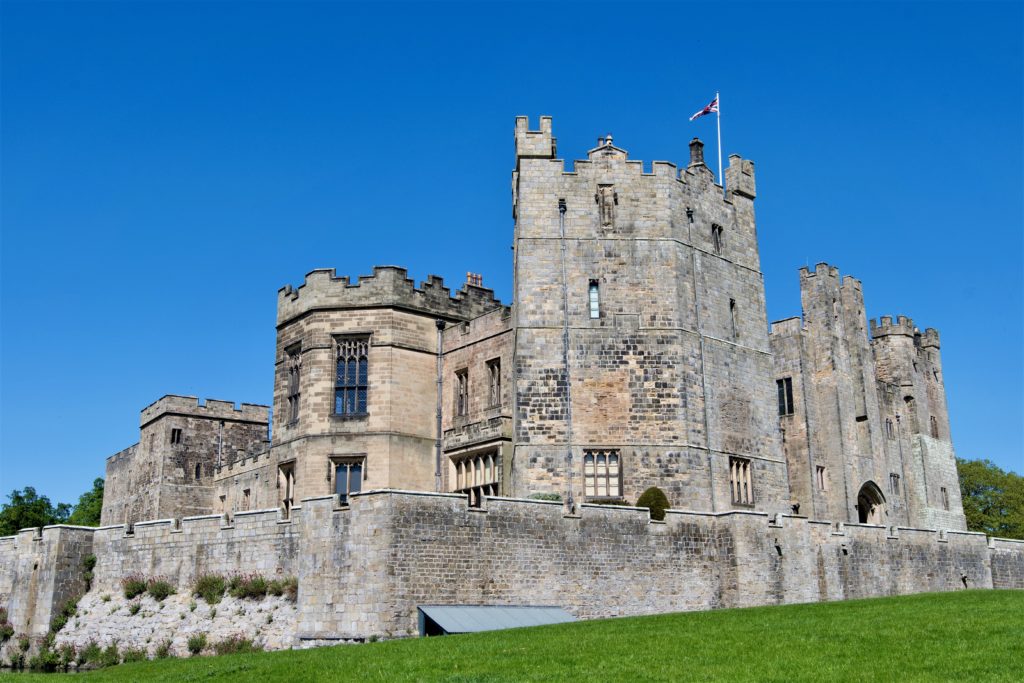
The Baron’s Hall was where much of the civil war machinations took place. Today, you can admire an art collection and a beautiful Neo-Gothic beamed ceiling.
The castle’s distinctive blue kitchen is really a pretty space. Dating to the 14th century, it has a collection of Victorian copper cooking utensils
Raby Castle offers 1 hour guided hours. You’ll get an informative history of the castle during its heyday, from the medieval Neville family up to the Vane family who still owns the castle today. You’ll hear tales of family disputes and the many royal visitors that Raby has hosted.
Raby is also a popular filming location. The castle doubled as the temporary Royal Family residence in the new Downton Abbey film. It was also featured in film Elizabeth (1998) and the popular drama series Victoria (2016-19).
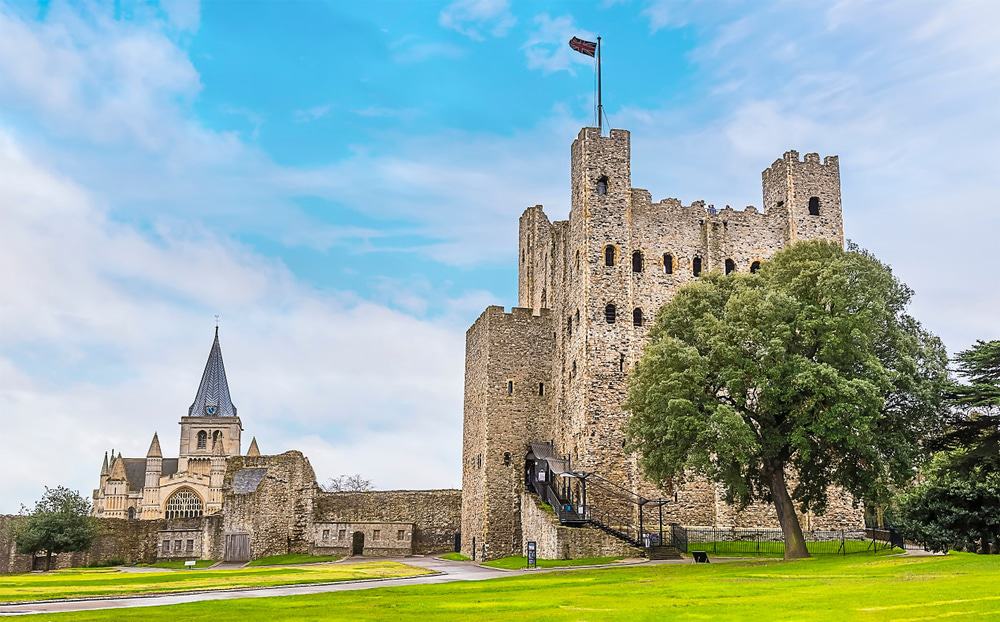
21. Rochester Castle, Kent
Rochester Castle has one of England’s best preserved Norman keeps. Dating from the 12th century, it’s also one of the tallest at 113 feet high.
The castle is just a shell now, but still steeped in history. William the Conquerer granted the castle to his half brother Odo, who built a strong motte and bailey castle. He was a powerful and clever man, but was brought down by his own ambition.
Odo made a bid for the crown in 1082. But lost a siege of Rochester Castle and was banished from England.
The present day castle dates from 1127. For almost a century, it remained in the hands of the Archbishop of Canterbury.
Later, barons rebelling against King John (the evil king from the Robin Hood tales) stole the castle. John took them down in a long, slow siege where the resistors were starved to death.
Rochester Castle was damaged during Simon de Montfort’s rebellion and again in the Peasants’ Revolt of 1381. Later kings weren’t enamored with the ancient keep and it fell into ruins, although the outer keep was preserved.
You can enter the keep and, if you are game, tackle the steep spiral staircase to the top of the battlements for views of the countryside.
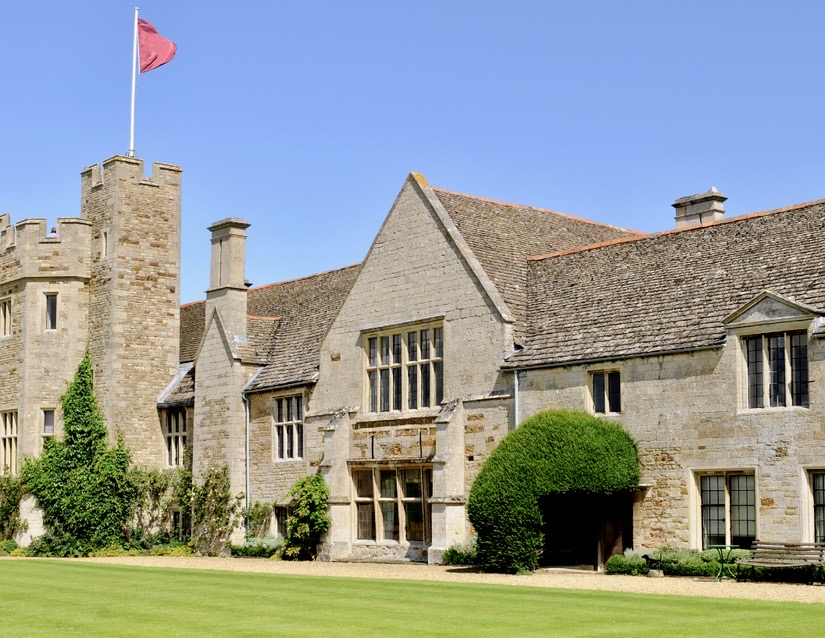
22. Rockingham Castle, North Hamptonshire
Rockingham Castle is a former royal castle and hunting lodge in Rockingham Forest. Rockingham has been the home of the Watson family since the 16th century. Before that, it was a royal enclave for 500 years.
Fortifications have been on the site since the Iron Age. The Romans and Saxons were there. William the Conqueror built the first castle after the Norman Conquest.
Rockingham is known for its sprawling hunting grounds and beautiful countryside views. This made it a favorite of medieval monarchs.
By the 15th century, the castle was no longer in favor. Henry III sold it to Edward Watson in 1533.
Unlike many castles in England, Rockingham still has vestiges of its medieval past. The castle’s Norman walls are partially intact, as is the 1290 gatehouse.
Inside, the Great Hall is filled with some important Tudor portraits, including one of Jane Seymour (Henry VIII’s favorite wife) and of Elizabeth I surrounded by her councilors.
The Long Gallery has some of finest paintings and furniture in the Castle. There are 18 acres of gardens with a 400 year old “elephant hedge.”
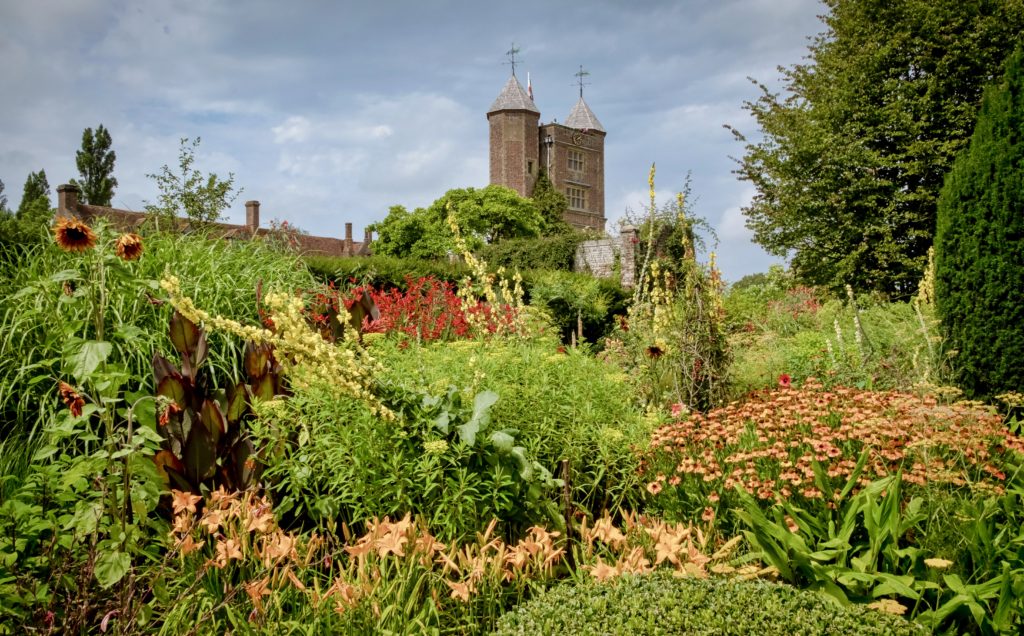
23. Sissinghurst Castle, Kent
Just 40+ minutes from Hever, Sissinghurst Castle is a National Trust property and major highlight for garden lovers.
Laid out in the 1930s, the castle boasts one of the world’s greatest 20th century romantic gardens.
Former owner and writer Vita Sackville-West designed the gardens to look like rooms of a house. Each one has its own color scheme and theme.
The gardens are most beautiful in spring.
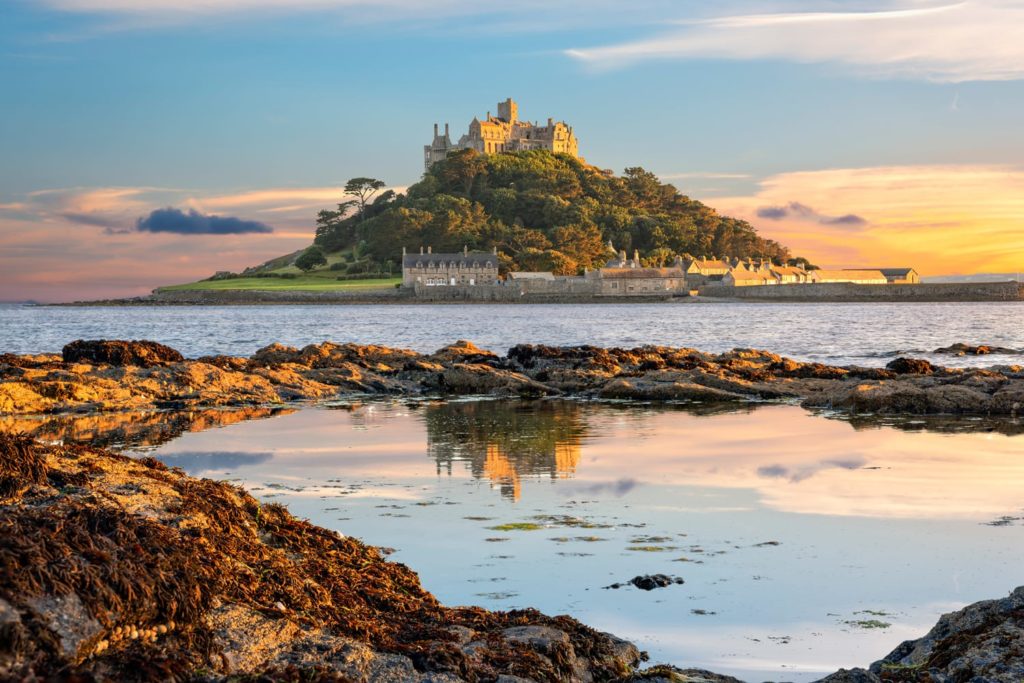
24. St. Michael’s Mount, Cornwall
1,600 feet from the Cornish coast in Mount’s Bay is a small tidal island called St. Michael’s Mount. It’s reminiscent of France’s Mont Saint-Michel. Often overlooked, it really is one of the best English castles.
The castle is accessible on foot via a cobblestone causeway that resurfaces during low tide or by small boat transfer.
During a history that began in the 12th century, St. Michael’s Mount has been a priory, fortress, place of pilgrimage, and, finally, the private home to the St Aubyn family.
In 1954, the St. Aubyns partnered with the National Trust to open the castle to the public. As you pass through the medieval doors, you can tour the armory, the Gothic drawing room, and a 14th century church.
The castle also boasts some exotic terraced gardens. In the summertime, the castle’s lit up to appear as if it’s floating in mid air on a calm sea.
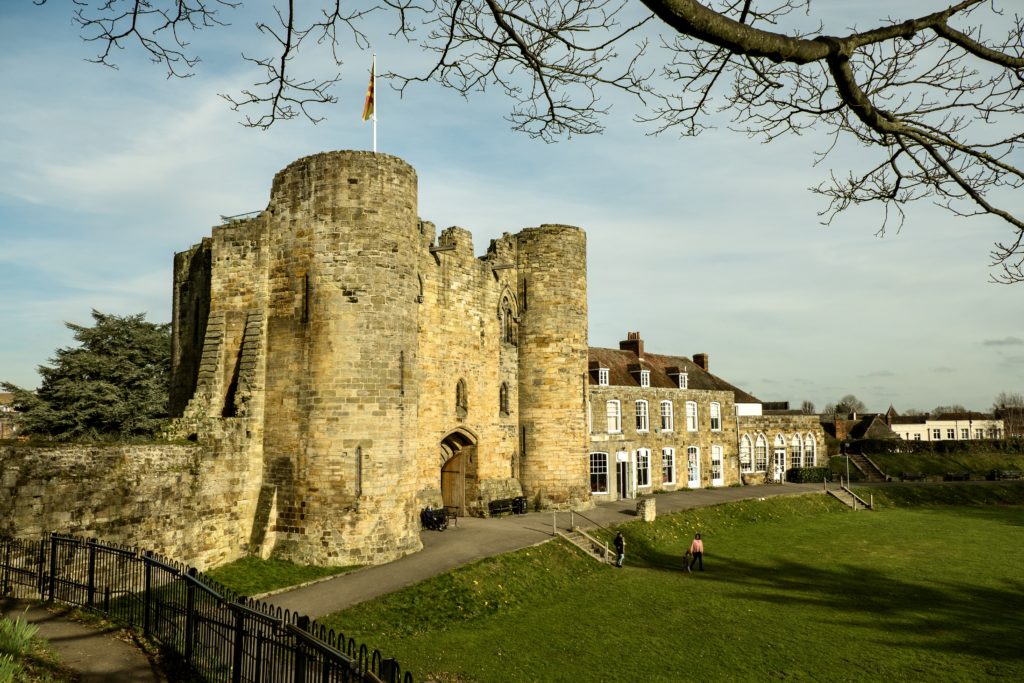
25. Tonbridge Castle, Kent
Tonbridge Castle is one of England’s most authentic medieval castle, standing guard (rather menacingly) over the market town of Tonbridge in Kent.
After being gifted the plot by William the Conqueror, Richard Fitz Gilbert built a wooden motte and bailey castle on the site. But Fitz Gilbert backed Odo against William in the civil war of 1088. William laid siege to Tonbrige and it fell.
Nonetheless, Fitz Gilbert’s son, Gilbert de Clare, became fast friends with William and rebuilt a stone castle.
In the late 13th century, another de Clare, the notorious “Red Earl,” built the mammoth 5 story gatehouse. The structure contained guard rooms, a great banqueting hall, and living quarters.
Today, you can enter the gatehouse and explore the great hall, winding stairs, and basement. Climb the battlements for breathtaking views across the town.
If you’re a fan of Madame Tussaud’s, you’ll love Tonbridge. Life size wax figures are scattered through the castle to give you slices of life from the Middle Ages. You can also get the complete scoop with the castle’s audio guide.
READ: One Week In Kent Itinerary
26. Tower of London, London
After Warwick Castle, the Tower of London is the second most popular castle in England. The Tower is also the most famous, with 900 years of history and blood.
It has served as a royal palace, a fortress, an infamous prison, a mint, a military storehouse, a treasury, home to the Crown Jewels, an armory, a public records office, a royal observatory, and a royal zoo. Even as a place of execution.
You will be blissfully immersed in the various successions of the Edwards, the Richards, and the Henrys.
It was here that Richard II abdicated, Henry IV was crowned, Henry VI was imprisoned (and possibly murdered), the princes of Edward IV were imprisoned, and Anne Boleyn was both crowned and executed.
William the Conqueror built the first version of the tower. In 1078, he authorized construction of what is now known as the White Tower, which took almost 20 years to build.
Over the centuries, Henry III and Edward I expanded William’s fortress. They added huge curtain walls with a series of smaller towers and enlarged the moat. Medieval kings and queens added luxurious apartments.
Here’s my complete guide to visiting the Tower of London. If you loathe queues, be sure to purchase a skip the ticket in advance.
The Tower is also free with the London Pass, which you will likely want to purchase if you’re in London for several days.
For a more in depth experience, you may want to book your own tour with an expert. I’ve taken this 3 hour guided tour and it was excellent. If you’re traveling with your family, check out this special 3 hour guided tour for kids.
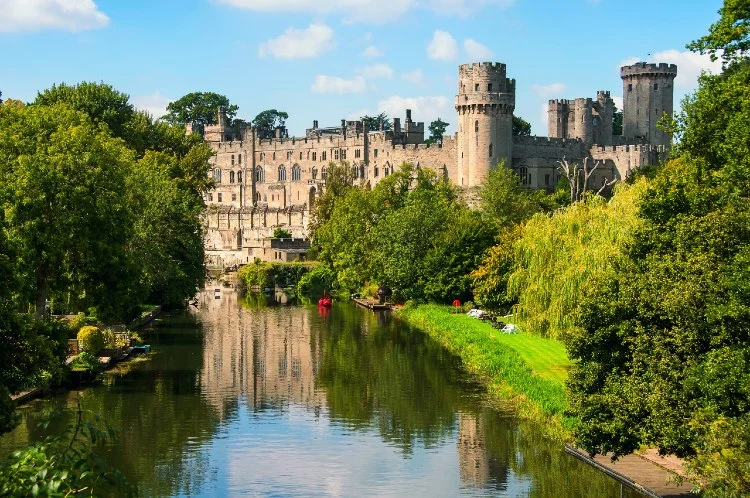
27. Warwick Castle, Warwickshire
Warwick Castle is one of the most significant castles in English history and the most visited castle in England. Your first glimpse will take your breath away.
The legendary Warwick Castle shaped 900 years of British history. The castle was built by a king. In 1449, it passed into the hands of the warmongering Duke of Warwick, Richard “the Kingmaker” Neville.
The castle was the backdrop for one the most famous dynastic conflicts in England, the War of the Roses. It was an epic battle for the throne between the House of York and the House of Lancaster.
The wealthy Kingmaker played chess with his Yorkist cousins, backing the monarch who best served his interests at the time. At one point, he imprisoned Edward IV in Warwick Castle and attempted to rule as uncrowned king.
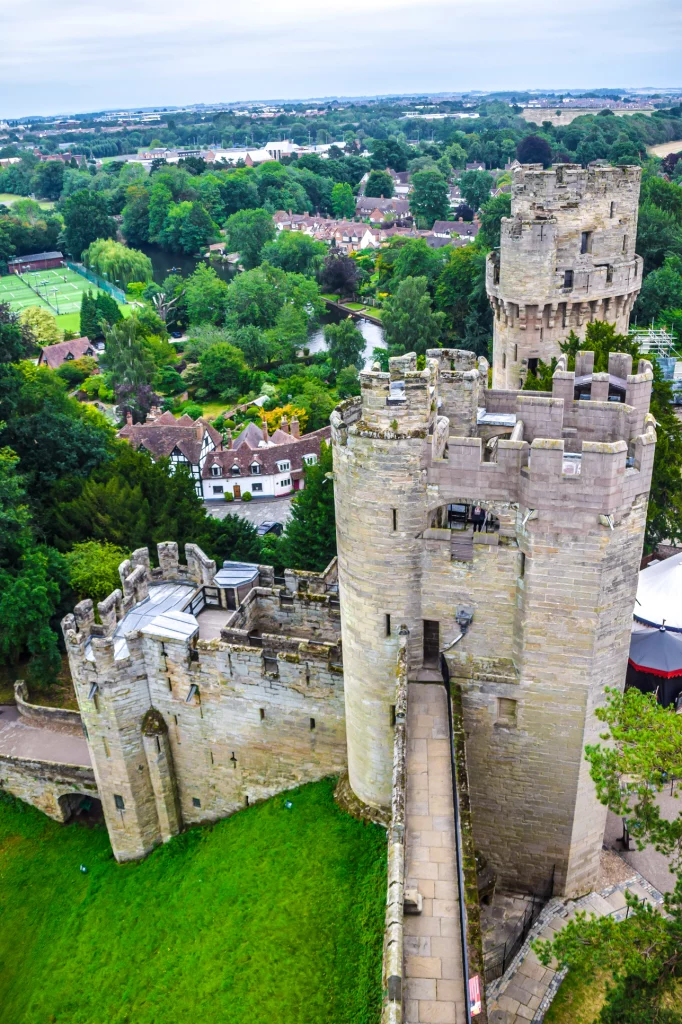
After his defeat at the Battle of Barnet, the castle eventually landed in the hands of John Dudley, an ally of Edward IV. He claimed the earldom, but then lost his head when he tried to promote Lady Jane Grey to to the throne.
With that rich history as a backdrop, you will love visiting Warwick Castle and there’s a tremendous amount to see.
Warwick is everything you’d expect in a storied fairytale castle – crenellated turrets, moats, and dungeons. You’ll want to walk the 127 feet tall high walls and climb Caesar’s Tower, the most majestic of the castle’s three primary towers.
Displays in the castle are also stellar. There is a magnificent Great Hall.
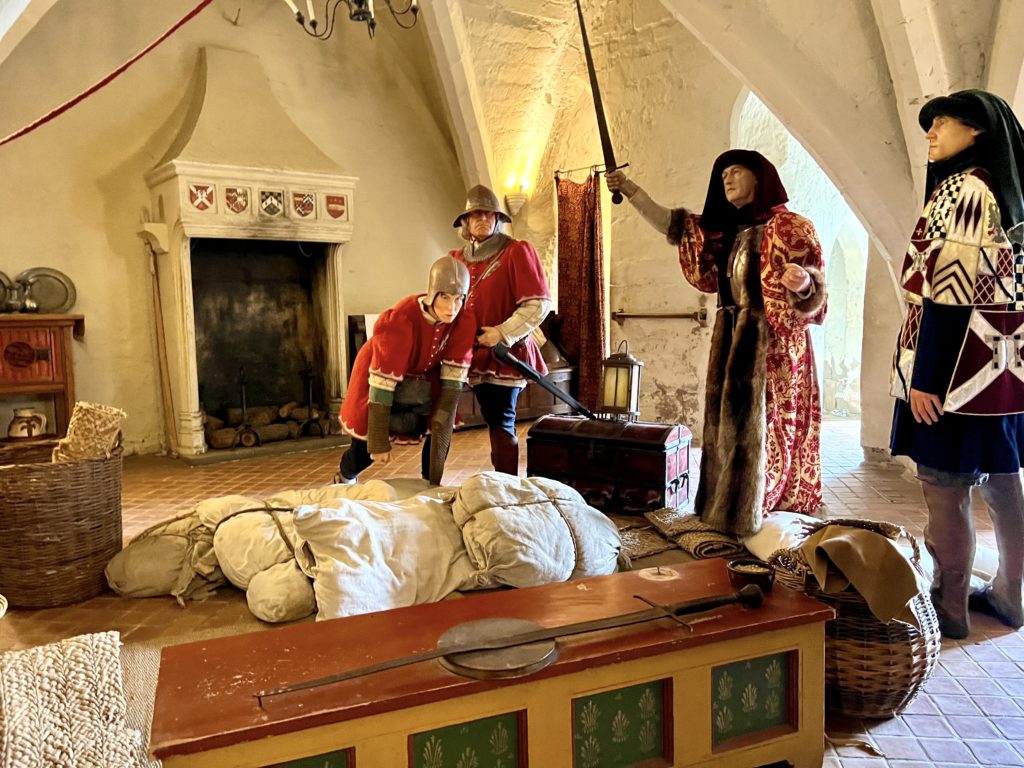
You’ll also see period furnishings, extraordinary life-like waxwork models, the state rooms, and reenactments that aim to give you insight into what life was like in a medieval castle.
The castle also prides itself on bringing history to life. The exhibition on “a day in the life of Richard Neville” is quite good. But other exhibitions make the castle seem a bit Disney-fied.
Here’s my complete guide to visiting Warwick Castle. Click here to book a skip the line ticket.
From London, you can book a self guided tour that includes train and entry tickets or a private guided tour from London.
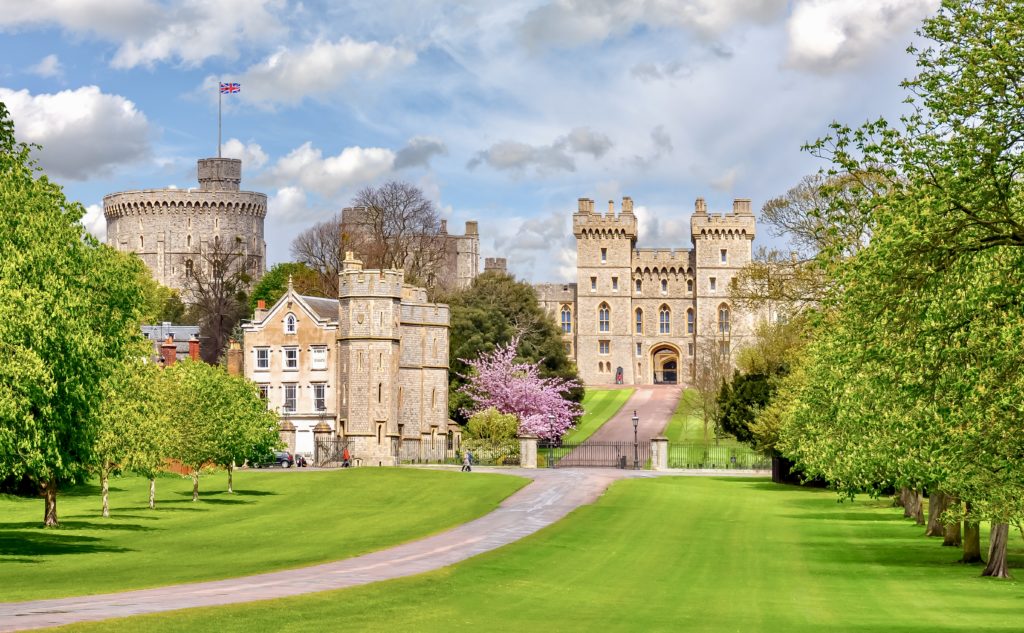
28. Windsor Castle, Berkshire
Windsor Castle is a striking 11th century castle that’s the official home of the royal family. This is my favorite castle in England and a must visit for history buffs.
Windsor Castle’s history is deep indeed. By legend, Sir Aurther and his knights of the Round Table met regularly in Windsor. William the Conqueror was the first builder, making Windsor one of his “ring around London” castles meant to subdue the city.
The castle is the longest occupied royal residence in the world. It’s been the symbol of the monarchy for 1,000 years. The castle was expanded by Henry II, Edward III, and Henry VIII.
Later, George III and George IV redesigned interior portions of the castle, wiping away some of its medieval roots.
You enter the castle through St. George’s Gate. At the castle, you can see the sprawling grounds, take the “long walk,” admire lavish royal staterooms and apartments, and visit a magnificent Perpendicular Gothic chapel.
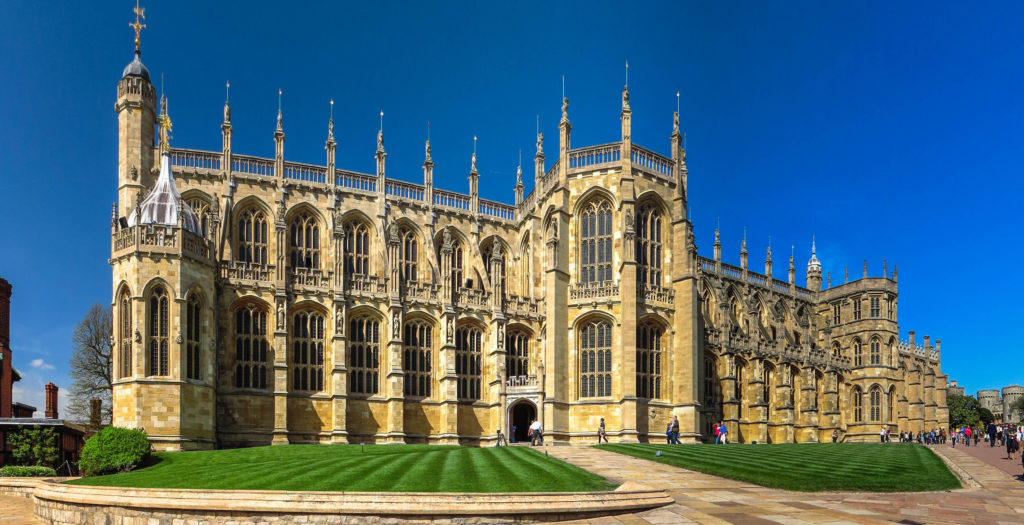
St. George’s Chapel is simply gorgeous. It’s the place to pay homage to ancient dead kings, including the infamous Henry VIII. The chapel is also the spiritual home of the Order of the Garter, England’s most prestigious club.
Not only is Windsor an authentic medieval castle, it’s home to some of the finest and most famous paintings in the British Royal Collection. You’ll find master works from English portraitists, the Northern Renaissance, the Italian Renaissance, and the Baroque eras.
Here’s my complete guide to visiting Windsor Castle. Click here to book a skip the line admission ticket. If you want to see the changing the guard, visit on Thursday or Saturday.
Windsor Castle is also included in the London Pass, if you have that card. Windsor is easy to reach from London. You can also book a guided half day tour to Windsor from London.
I hope you’ve enjoyed my guide to the best castles in England. You may enjoy these other England travel guides and resources:
- 3 Day Itinerary for London
- 5 Day Itinerary for London
- Hidden Gems in London
- 30 Day Trips from London
- Tourist Traps To Avoid in London
- Best Museums in London
- One Day In Canterbury Itinerary
- One Day in Oxford Itinerary
- One Day In Stratford-upon-Avon
- Harry Potter Places in London
- Guide to Westminster Abbey
- Guide to St. Paul’s Cathedral
If you’d like to visit England’s best castles, pin it for later.
